CREAM OF THE CROP
The seed to feed journey


Living the high life
Sustainability in the high-country
Rise and vine
Kiwifruit growers prepare and reflect

AUTUMN 2023 FARMLANDER CREAM OF THE CROP RRP $12
AUTUMN 2023



We're out here too.



You wanted an SUV with uncompromising capability, safety and comfort. A complete SUV: tough on the outside, sanctuary on the inside, and ready for everything ahead of you and your family. You demanded it, we built it: introducing the Next-Generation Ford Everest. • 3.5 tonne towing capacity2 • 7 Seater • 360 Degree Camera3 • Off Road Screen3 • Hands-free Liftgate + ORC + CO2 Emission Fee1 $ 71,990 Starting RRP Next-Gen Everest Conquer New Zealand 4 1. Available at participating Ford New Zealand dealerships. Recommended Retail Price (RRP) stated is for Everest Trend 2.0L Bi-Turbo and includes GST. Price excludes any dealer on-road, accessories and fitting costs. Prices also exclude the Clean Car Programme CO 2 emission rebates and fees. To learn more about the Clean Car Programme, please visit https://rightcar.govt.nz/clean-car-discount. Please contact your authorised Ford Dealer for full pricing details. 2. 3.5T max. braked towing capacity when fitted with genuine Ford Tow Pack. Please see Owner’s Manual for more information. 3. Driver-assist features are supplemental and do not replace the driver’s attention, judgment and need to control the vehicle. May not operate in some driving and road conditions (including at certain speeds) or adverse weather. 4. Warranty conditions and exclusions apply. Visit www.ford.co.nz/owners/warranty for further information. To book a test drive and access exclusive shareholder pricing, contact your local Ford Dealership.
FARMLANDS PUBLICATION TEAM
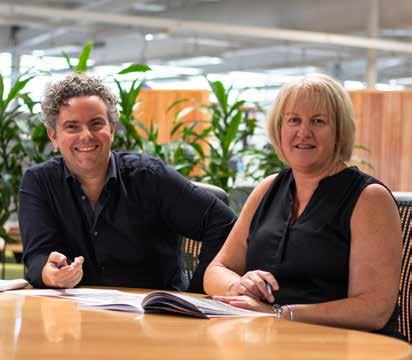
Deborah Allan
Ian Turner
CONTACT
Farmlands
535 Wairakei Road, Burnside, Christchurch
Ph: 0800 200 600
Email: farmlander@farmlands.co.nz

CONTENT & DESIGN BY SCG
David Nothling-Demmer
LauraGrace McFarland
Julian Pettitt
Ayla Miller
Bernadette Basagre
PRINTED BY: Webstar
ON THE COVER
A plan for success
Welcome to the Autumn 2023 edition of Farmlander, where we’re helping you plan for tomorrow, today. Recently, our Chief Executive Tanya Houghton was asked – on her way to a Future-Planning session – what the five year plan for Farmlands was. The response went a little like this.
This publication is printed on paper made from pulp that is environmentally certified, and from renewable and sustainable sources using vegetable-based inks. It is Elemental Chlorine Free (ECF) and manufactured under strict ISO 14001 Environmental Management Systems (EMS). The plastic wrap is 100% recyclable in the New Zealand soft plastic recycling scheme.
This publication has been printed by Webstar, a Toitū enviromark diamond certified company and a winner of a Green Ribbon Award “Minimising our Waste”.
The information contained in this publication is given in good faith and has been derived from sources perceived to be reliable and accurate. Whilst every effort is made to ensure the accuracy and correctness of the information, Farmlands gives no warranties, express or implied, regarding the information nor does it accept any liability for any opinion or information (including the accuracy or completeness thereof) or for any consequences flowing from its use. The information and views expressed in this publication are not necessarily the views or opinion of Farmlands, its editorial contributors, freelancers, associates or information providers. Independent advice is recommended before acting on information or suggestions contained herein.
Readers who rely on this information do so at their own risk. Reference to any specific commercial product, process, or service whether by trade name, trademark, manufacture, or otherwise does not constitute an endorsement or recommendation by Farmlands.
No part of this publication may be reproduced in any form without the prior written permission of the publisher.
Prices and offers apply only in the time-period stated on the front cover of this publication and while stocks last.
Not all products are available at all Farmlands stores. All prices include GST unless otherwise stated.
“The way the pace of change is across our business and the agri sector in general, it would be a mistake to set in stone now everything we’re going to do and how we’re going to do it. Prices change, people change, technology changes, so we have to look at planning very differently. We need to be clear on our direction, on our purpose, then we have to take advantage of all the intel and all the expertise we have on hand to make the best decision we can at any point in time.”
Farmlands is fortunate to have a hugely diverse team, using their skills, knowledge and experiences to help make your business more profitable. Dig deep into this fantastic issue and use it to help make the best decisions this season. If you do have feedback on anything we talk about in the latest issue or there’s a story you think we should be telling, please email farmlander@farmlands.co.nz

Have a great season.
Ian & Deborah
Got something to share with the team at Farmlander?
Email us at farmlander@farmlands.co.nz
Keep up-to-date with the latest news from across the co-operative via our website and social media.
@farmlandsnz @farmlandsnz
Farmlands Co-operative Society Limited
 The family line: Alastair Barnett and daughter Honor stroll amongst rows of barley.
The family line: Alastair Barnett and daughter Honor stroll amongst rows of barley.
AUTUMN 2023 AUTUMN 2023 FARMLANDER CREAM OF THE CROP Rise and vine Kiwifruit growers prepare and reflect Living the high life Sustainability in the high-country
Photograph by Elise Rutherford Design by Julian Pettitt
The seed to feed journey
CREAM OF THE CROP
Ian Turner and Deborah Allan.
UP
| Welcome from the team farmlands.co.nz | Farmlander | 3
FRONT
GETTING STUCK IN
Tēnā koutou katoa,

I’m pleased to share the second edition of our revamped Farmlander magazine. It’s full of great industry insight and success stories and with you just in time for autumn reading. We’ve received lots of positive feedback about the first edition – thanks for letting us know what you think. I hope you enjoy this edition even more.
We understand that the summer season has been a challenging time for our growers, with significant weather events in many parts of the country disrupting your plans.

Creating even more uncertainty are the economic headwinds that we all face – including high interest rates, continued inflation throughout the entire supply chain, an incredibly tight labour market and low consumer confidence leading to reduced discretionary spending. The indication from Government and many economic analysts is that Aotearoa will enter a recession this year, for the first time since 2008. In addition to these factors, our industry is also dealing with significant regulatory change – with He Waka Eke Noa top of mind for all.
At Farmlands, as your buying co-op, we understand the challenges you face and it’s our responsibility to be alongside you, with a focus on improving farm profitability. The Farmlands whānau/team are working hard to ensure we have a co-op that delivers on this. It's why Farmlands was established in the first place. It means doing things differently, to be more adaptive in the ways we support your changing needs and most importantly, to ensure that we are making progress on how we use your collective buying power and scale to deliver value to you.
We have a plan in place to make this happen. Like you, we are thinking to the future needs of our customers, looking for where and when Farmlands should grow throughout this period. Our plan is simple – do the basic things that you need from your co-op well.

Over the last few months, we have made some great progress. We’ve been busy growing our already-strong
base of technical expertise and sales support teams, so they are available to you on-farm, instore, over the phone or online. Our new Chief Sales Officer, Blair Robinson, joined the team in late January and his primary focus is on continuing to develop this team. We’ve started to deliver our new product strategy with seven stores initially moving to centralised purchasing and inventory management. These moves will increase our collective buying power, which is after all the purpose of your buying group. When you visit these stores (Invercargill, Darfield, Richmond, Marton, Opunake, Matamata and Helensville), you’ll notice changes to store layout, a consistent range of products on offer and improved stock availability, while our team in-store continues to provide you with all the support you need.
These are just a couple of examples of how we are moving – there will be many more to share in the coming months. Even with our strong plan, the economic factors impacting businesses are also impacting Farmlands. This means our growth over the next couple of years will be a little bumpy – as indicated by our half-year result (outlined on page nine). As we work together, we’ll come out of this period stronger – just as we have before. We know that Farmlands will grow if we continue to focus on better supporting you, and you continue having faith by backing us with your purchasing decisions.
4 | Farmlander | farmlands.co.nz Got a question for Tanya? Reach out via asktanya@farmlands.co.nz
Nga - manaakitanga (With best wishes)
Like the co-op’s farmer and grower shareholders, Farmlands is carefully managing its way through a challenging 2023 operating environment –that includes difficult economic conditions to extreme weather events.
Farmlands remains focused on delivering its shareholders value by helping them improve on-farm profitability, delivered through product pricing and the potential of a 2023 distribution. “It’s part of my commitment to shareholders to be upfront about the realities we currently face as your co-op. These are unpredictable times. I know if Farmlands and you, our customers, work together then we can remain strong through this period,” says Farmlands CEO, Tanya Houghton.
“We know that farmers and growers are doing it very tough at the moment and this is always going to directly impact our business, as a key rural supplies provider.
The good news is that as a result of the changes that Farmlands has made in the last 18 months, the co-op is in a stronger position to manage these conditions.
“We’ve done a lot of the hardwork streamlining how we operate as a business, focusing on how we better meet our customers needs and setting ourselves up to be able to change direction quickly in times like these,” says Tanya.
At 31 December 2022 – the halfway point in the financial year – Farmland’s revenue is slightly ahead of the same period last year at circa $470m*. In an environment of 7 percent plus inflation, what this actually says is that normalised sales are down compared to the previous year. Customers, particularly core farmers and growers, are holding off on non-essential spend in areas such as infrastructure, capital
fertiliser, agronomy, retail and, in some cases, animal health.
Farmlands is faced with inflation throughout the entire supply chain, high interest rates and the need to look after employees in a tight labour market – or, in other words, rising operating costs. The co-op is working hard to minimise costs and make smart systems and people investments for the future, while also maintaining a strong EBITDA position of $17m* at the half-year point. This half-year result has been achieved even as the co-op has made a multi-million dollar investment in its supply chain transformation programme (explained on page 22) that is set to support significant EBITDA growth in future.
Overall operating profit (before tax) is in a very strong position at $24m*, and has been boosted significantly by the one-off profit from the sale of Farmlands’ fuel business, into the new joint-venture Fern Energy. Without this boost, operating profit would still be healthy at circa $5m*.

“The next six months is critical for Farmlands – particularly with our ambition to deliver a shareholder
distribution for this financial year,” says Tanya. “We are focused on delivering excellent service on-farm, in-store and online – and the best pricing – to make Farmlands the obvious choice for our customers to shop. If our shareholders and customers get in behind us, and choose Farmlands for their rural supplies, we can build on our EBITDA and position Farmlands to deliver more value to shareholders this year.
“Through autumn, we have deals and offers on the products that are important to customers at this time of year – such as autumn calving; picking and pruning; spraying and re-seeding; and getting the right feed solutions in place in the lead up to winter. Farmlands is also introducing new ways to get even better prices, with group buying propositions such as ‘All-In’ Deals. This is all aimed at making it easy for customers to choose to direct their spend to Farmlands and, therefore, improve the returns they get from their co-operative.”
*All half-year financials shared are unaudited and may be subject to change.

farmlands.co.nz | Farmlander | 5 UP FRONT | From Tanya
Up Front Special Section

AUTUMN Inside our issue
4 From the CEO Tanya Houghton reflects on how significant weather events have impacted farmers across the country and shares how Farmlands is poised to help, no matter what the challenge. 8 Our story From former Chair of Combined Rural Traders Limited (CRT) to overseeing the merger with Farmlands, Don McFarlane reflects on the evolution of the co-op. 10 Clippings News, views and reviews from across the business.
A handy list of things to check off in preparation for the autumn months.
46 Autumn Checklist
PHOTO: CHLOE LODGE
Lay of the Land The Big Picture
66 A silver lining
Fifth generation farmer Alan Curnow reflects on how the power of community helped him and his wife Sandy get through some dark days after a massive flood left them stranded.

70
Regenerating the kiwifruit industry
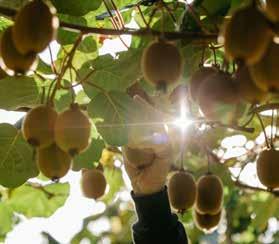
Following the severe weather events that hit the kiwifruit industry last season, we take a look at how the recovery efforts are tracking.
82 Seasonal snippets
16 Awakino Station
For Dan Devine and his young family, managing Awakino Station comes with a responsibility to preserve it for future generations.
20 Seed to feed
We follow the journey of Farmlands’ feed from seed grown by shareholders for shareholders.
26 Market outlook
ASB’s General Manager Rural Banking Ben Speedy looks at how global events, pricing and demand will impact Kiwi farmers and how they can prepare.
28 Sowing the seed
As farmers look to supplement their incomes in various ways outside their usual fields, we take a look at what’s trending in overseas markets.
30 Remote access farming
Emerging agricultural innovation hub Future Whenua looks at how new technology and new ways of thinking is set to change the way we farm.
34 Ma - ori modern agriculture
Thomas Rawiri, Farmlands Cultural Advisor, shares his thoughts on how Farmlands can best support the rapidly growing sector of Māori agriculture.
37 Girls who grow
Young farmer Aimee Blake is empowering a new generation of women to build a career in the primary industries.
38 Deer hunting
Keen hunter Joe Morrison talks to Alice Scott about his charitable venture that both helps with wild deer eradication and passes on the venison to those in need.
Trends, take-outs and tips on autumn planning.
88 Century Farming profile
Brought to you by Century Farms, we explore the origins of one of New Zealand's iconic sesquicentennial farms.
90 Local takes the lead
The Brother’s Green are working hard to change public perception of hemp and market this misunderstood plant globally.
94 Make the most of your shareholding
From discounted farm inputs, power, fuel and even savings on the weekly grocery shop, there are thousands of ways to use the Farmlands Card.
96 The last word: Wynn Williams
Partner and specialist property lawyer Annabel Sheppard shares her expert advice on rural property management.
20 70
From Chair of Combined Rural Traders Limited (CRT), to overseeing the merger with Farmlands Co-operative Society Limited, Don McFarlane has seen a thing or two in his time. Now having hung up his Directors hat, he reflects on the values CRT brought to Farmlands and why the power of a co-operative will never get old.
With farming, and a bit of business in his blood, Don’s life-long involvement with farming cooperatives was borne from the desire to help others like him get a better deal.
Although retired from Farmlands now, he is still very much connected to the farming way of life with his son Hamish running the family’s 575ha mixed arable farm, where they grow wheat, barley, grass seed, potatoes and carrots for processing and currants for Barkers.
Don’s interest began initially while he was studying Commerce at Massey University and happened to do a case study of the South Canterbury Rural Co-operative Society which was a forerunner to CRT.
“The study piqued my interest so when the opportunity came to join the board some years later, I took it and I guess I grew from there.
“My grandparents were shopkeepers so maybe I was always destined to be a shopkeeper,” he jokes.
As the years went by he saw a number of mergers take place long before Farmlands was involved.
“The genesis of the rural retail movement goes right back to the 60s and 70s in New Zealand when the market for farmer inputs was very protected with tariffs and licensing,” he says.
“There was significant margins on chemicals – about 70 percent and similar margins on polythene piping and so on.”
Around the same time, groups of farmers in the North Island and the South Island were wanting to do something about reducing the prices of the goods they needed to run their farms.
“In the South Island there were seven different independent regions that all set up their own buying groups with their own boards and they raised their own capital.
“For many years there was a group of independentlyminded buying groups operating usually with charge cards rather than shops, although they did progress to retail outlets as time went by. That was the genesis of what became CRT.”
As time progressed the South Canterbury Rural Cooperative Society decided they wanted to join up with some of the other groups and formed a loose organisation called the Combined Rural Traders.
“The idea was to buy collectively, to get better buying terms and to share knowledge and costs where appropriate,” Don says.
“This worked through the 80s but it was a bit dysfunctional. There were lots of very strong minded individuals and it never settled comfortably.”
Deciding this dysfunction was too much to handle, the South Canterbury group left and formed a series of side mergers with the North Canterbury and Southland equivalents, calling themselves Greenfields and Landbase.
It was from here that the CRT which merged with Farmlands began to form, when Greenfields and Landbase approached the original CRT proposing they have a full commercial merger. This new CRT had one management structure, one board of directors and one clear business plan.
“That took place in 2004 which was the start of the CRT that finally merged with Farmlands,” says Don.
For the next nine years CRT continued to grow and diversify its business.
Not only did it have a retail operation with the charge card set-up. It also had several businesses that produced feed for cows and sheep as well as a fish meal factory in Dunedin “much to the disgust of the neighbours” due to its rather “special” aroma Don adds.
“We also produced pellets for pet rabbits in our feed mills, during a time when our farmer customers were trying to rid themselves of rabbit plagues in Otago. So we didn’t say too much about that sort of diversification!”
Fuel was also a large part of CRT’s business along with the establishment of a real estate business and a livestock trading business which operated across the South Island.
8 | Farmlander | farmlands.co.nz
PHOTO: CHRIS STANLEY, FOCUS PHOTOGRAPHY
Over this time, CRT grew from a company with a $360 million turnover to, when it merged, a turnover of $1.3 billion. There was also an increase in profits from $3 million to $13 million in that nine year period

Throughout this, CRT remained “strongly focused on a broad-based diversified basket of offerings” led by “growth orientated” Brent Esler as the Chief Executive and a very enterprising Board.
As a retired police officer with an MBA, Brent was known for owning a “very smart BMW motorbike and leathers” as well as “playing his rock guitar with his band at award evenings”.
“He was a very adaptable, very enterprising CE,” Don adds.

After a successful stint on its own, CRT merged with Farmlands in 2013 with Brent going on to be the Farmlands Chief Executive designate for the first three years and Don as Deputy Chairperson bringing with them some uniquely CRT values.
“We always recognised the purpose of CRT was to reduce shareholders cost and provide competitive pricing,” Don says.
“So we were very focused on cooperative values and returning a rebate to shareholders. In our last year when we made a profit of $13 million we returned $10 million in rebates to the shareholders at the end of the year.”
This strong business focus was combined with the “family feel” where the co-op held a number of events from Ladies Evenings to sports events with the staff.
“A co-operative is different to a corporate because the former is working for the shareholders rather than the customer,” Don says.
“The values of the co-op are important, what it stood for and the growth and diversification. The new Farmlands has been through some challenges but I think it still has the potential to deliver. I still believe in it. Ultimately he tangata, he tangata, he tangata, it is the people, it is the people, it is the people.”
farmlands.co.nz | Farmlander | 9 UP FRONT | Change maker
Industry news and development updates
Keeping your chooks happy and healthy

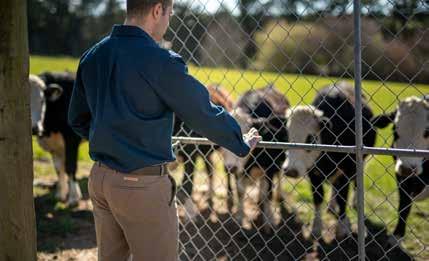
We’re seeing more customers visiting our stores with an interest in keeping chickens and enjoying their own eggs.
Farmlands is one of the country’s leading suppliers of chicken feed and associated products – so we have some great resources and advice available for customers on keeping chickens. Like with any animal ownership, it’s important that customers understand how to look after their chickens the right way to ensure they’re healthy and happy.
You can check out the Chook Book for helpful information. Download a copy here:
WHAT’S HOT Shop the look
TUSSOCK CREEK
WINTER
MOLESKINS
Men's heavyweight and durable moleskin trousers
Colours: Taupe, Olive, Beige, Black, Lovat. Size range: 76cm-112cm For more, visit: www.tussockcreek.com
10 | Farmlander | farmlands.co.nz
CLIPPINGS
Find in-store at Farmlands or online at shop.farmlands.co.nz
POULTRY
FARMLANDS CONCEPT STORE Ashburton now home to Farmlands’ fresh new store concept
Back in December Farmlands opened a new store in Ashburton, the first in seven years. The opening of this large ‘concept store’ was celebrated during the weekend 9 – 11 December with appearances by Santa, prize draws and in-store specials.

CEO Tanya, says that the innovations that customers will see in the store demonstrate the new direction that Farmlands is taking in how it serves its customers.
“We are proud of our stores and want to provide our customers with a great experience when they visit us.”
“We are providing all the key elements of a Farmlands store, while also widening our focus so that our stores can be community hubs –places where people can both get the things and expertise they need, combined with having a social, interactive experience.
“Our new store in Ashburton is the first in our network built to reflect

the future vision for the Farmlands’ store network. It provides easy access to farming fundamentals such as Nutrition, Grain and Seed, Dairy and Horticulture products and a great layout for other ranges such as clothing and shoes. We also have brand-new concepts such as a pet-wash; "The Shed" a dedicated area for purchasing chemicals, restricted items and the odd conversation; plus the ‘Feed Barn’, which expands the range of nutrition products available to customers.”
Tanya says that the intent is to go back to Farmlands’ origins as a one-stop shop for product, professional services, conversation and lifestyle activities for everyone connected to the land.
“It’s all about delivering great customer service – making sure that Farmlands is a natural place for customers to meet, hang out and get advice. We think our new Ashburton store is an awesome space, one that reflects a future Farmlands. We’ve
received really positive feedback from our farmers, growers and lifestyle property owners who’ve already visited the store.”
The Ashburton store, led by Kane Chambers, was formally introduced to the community during the three-day opening event.
“I love how open and bright it feels, we have plenty of space to showcase products. It’s a great environment to work and shop in, a lot more welcoming and just gives us the ability to stock the right items,” says Kane.
He says that there are exciting times ahead for Farmlands, and that it’s great to see the cooperative trying new things that can then be rolled out to the wider business.

The next store to undergo a customer service transformation will be Rangiora.
“We are well down the track with plans to upgrade our Rangiora store. As in Ashburton, we have started by looking specifically at what everyone connected to the land – farmers, growers and lifestyle property owners – need from their local Farmlands store. We are designing an in-store experience to meet the needs of the Rangiora community,” says Tanya.
“Each of our stores has its own personality, lay-out, products and focus. We’re not taking a one-sizefits-all approach – each store will reflect the unique make-up of our shareholders and customers in each region. For example, in the revamped Rangiora store, we’ll be testing a drive-through Feed Barn.”
farmlands.co.nz | Farmlander | 11 UP FRONT | Clippings
Kane Chambers.
We're Our Extending Weekend Hours
We know rural life isn’t Monday to Friday, so we’re starting to extend our hours across some stores to make weekend shopping easier.
To find out when your local store is now open head to farmlands.co.nz/storelocator

OUR MAGAZINE
We hear you!
The mission of Farmlander is to tell the stories of our shareholders and rural communities, demonstrating we are the go-to for everyone connected to our land.
Content in the magazine ranges from big reads about developments in the primary sector to snap-shots of life across rural New Zealand.
The feedback for the first issue of the magazine has been exceptional. Here’s a few comments from across the country: Good content and a broad variety of Farmlands stories, with a diverse topic range. – Hawera
I like the paper type, matte finish. Not glossy like a gossip mag. It’s the type of magazine I want to keep. – Otaki
I normally only have a quick flick through. However, the latest issue I actually read completely which is a real testament as to the quality of the articles both in information and structured content. – Rangiora
Feel it has a more broad appeal with lifestyle type articles and recipes included. Coming out only 4 times a year also gets a tick from me. – Gisborne
If you have something to contribute or suggestions on how we can bring to life more great reads, get in touch via farmlander@farmlands.co.nz

TAG YOUR CHARITY

Supporting rural New Zealand
Back in December, Farmlands joined with I Am Hope as a national partner for its Tag Your Charity Christmas campaign, alongside 80 local charities chosen by individual stores. The amazing effort raised over $130,000 for these charities, all of which goes directly to help them do their work.
A big thank you to everyone who contributed in some way to support the rural communities we serve. For more news and events from Farmlands, visit www.farmlands.co.nz/NewsAndEvents
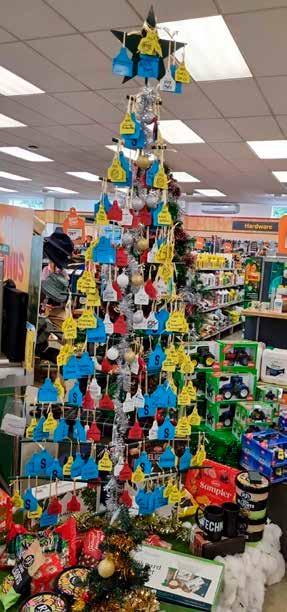
farmlands.co.nz | Farmlander | 13 UP FRONT | Clippings
The Big Picture

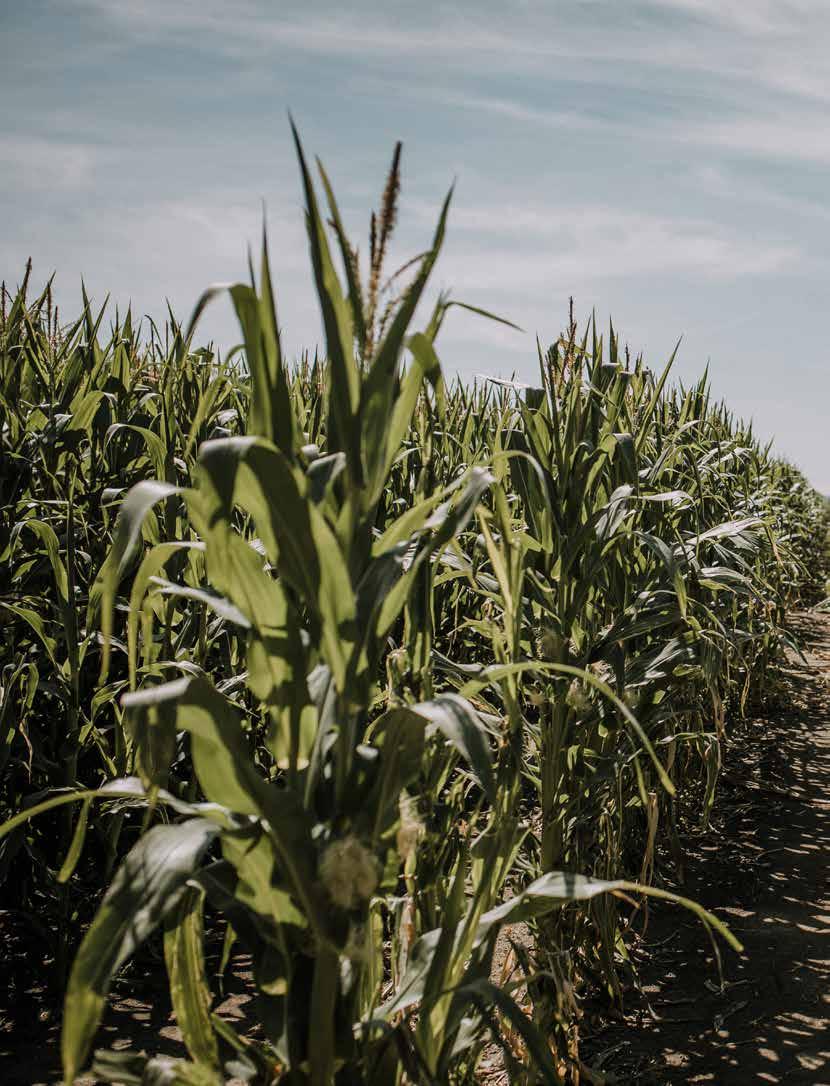
14 | Farmlander | farmlands.co.nz
In this section
From inspirational tales of sustainability to rapidly growing industries and market outlooks – this section showcases shareholders’ stories and beyond.

16 As custodians of the land Dan Devine and his young family are passionate about preserving it for many future generations to come.
20 From tiny seeds to livestock feed, we follow the journey from field, to mill, to farm.
30 A look into the future of farming and the innovative solutions coming out of the Future Whenua rural innovation and biodiversity hub in Southland.
farmlands.co.nz | Farmlander | 15
Photo: Elise Rutherford
FARMING FOR THE FUTURE
A short drive from Kurow on the East Coast of the South Island lies Awakino Station, a high-country sheep, beef and deer farm and home to Dan Devine, his partner Jaz Mathisen and their three young daughters, Ava (6), Ida (2) and newborn Betsy.
 WORDS BY AYLA MILLER CHLOE LODGE
WORDS BY AYLA MILLER CHLOE LODGE
As the first Devine to manage the property since Dan’s grandfather took it over in 1988, the couple recognise their role as custodians of the land and have been making sure the land and the business remain in good shape for generations to come.
Both coming from a farming background, Dan met Jaz when they were working at Cleardale Station. Back in 2016, Dan was offered the role of manager at Awakino Station and the couple happily took it up.
The station stretches across 7,500 ha and winters about 24,000-25,000 stock units with a team of six full-time staff, including Dan. Along with being an active farm, the property also features a ski field, a public walking track on the Kurow side and is part of the Alps to Ocean cycle trail. The farm is also in partnership with a safari business which hosts predominantly American game hunters. The station provides the deer and the wealthy tourists are invited onto the property to shoot them.
Dan says that while he runs this station as he would run any other, having a family connection to the land “gives you more of a feeling of home”.
“As far as the farming goes, it’s treated as a business but there is possibly a bit of sustainability and longer-term goals put in place with it being a family farm, because we want to look after the next generation,” he says.
“Basically, if we are not sustainable, we are going to run ourselves into the ground. Jaz and I, at a very early stage realised that we
16 | Farmlander | farmlands.co.nz
Dan Devine and Jaz Mathisen, with their youngest daughter Betsy and a pet lamb.
are just custodians of the land at the moment. So we need to look at the next generation and the future and set up things for them.”
For the station, this means ensuring the land isn’t over-grazed and also choosing to get two uses out of their stock. Jaz is in charge of planting and she usually collects seeds from around the farm to replant natives where needed to add to the farms overall biodiversity.
“Our management process is very much around rotational grazing, leaving enough behind so we aren’t running things into the ground,” Dan says. “The only time we really set stock is around lambing time and that is to give the ewes a chance to lamb, otherwise most things go on rotation.”
The station also multi-grazes with different species. “We’ve got sheep, beef and deer, so that gives us really good opportunities to be able to graze blocks in a way that is more sustainable than set stocking and to cover our worm burn and everything else.”

When the couple first moved to Awakino, the property ran Merino and Romney sheep but are now breeding the Romneys into halfbreds, wanting more dual-purpose animals. This decision was made because the Romney’s were “quite inefficient” says Dan.

“They were carrying around 76 to 78 kilos of body weight and producing 1.5 - 1.8 lambs based on our scanning and lambing percentage and we wanted to change that. We could see that the crossbred wool market was going to fall through the floor, which it has done, so we needed more of a dual-purpose type sheep.
“We changed to halfbreds in a five-year plan so that if we got halfway and we didn’t like what we were breeding we could always change and we actually did change to a 3/8th breed.”

farmlands.co.nz | Farmlander | 17
THE BIG PICTURE | Awakino Station
Top right: The deer on Awakino Station are dual purpose, providing both venison and velvet. Bottom right: Ava (6) and Ida (2) enjoy helping out on the farm.
The dual-purpose trend also extends to their cattle which are bred for beef and also sold in-calf, along with the bulls to dairy farmers, while the deer produce venison and velvet.
Back in 2004, when things going viral was still a fairly rare phenomenon, Dan found himself in the middle of a news story that made headlines around the world.
While working on Bendigo Station he hoisted the recently discovered Shrek the sheep (a hermit Merino wether) onto his shoulders. This image, captured by the Otago Daily Times became an international sensation.
Self-described as “quiet” and “a little bit reserved” Dan said the attention came as a shock but overall it was an exciting journey.
“It was amazing. For a little wee country boy with no exposure to media or anything like that it was huge. It gave me a bit of a fright when it turned into an overnight story that went all around the world. All of a sudden there were helicopters and press turning up and outings to see the prime minister and everything else. It was a massive adventure; it was good to be able to live that sort of thing and see what it was like I suppose.”
Having only very recently welcomed their youngest daughter Betsy into the world, Jaz has taken a step back from the hands-on farm work to take care of the children, the older two who are frequently found running around freely in bare feet and minimal clothing.
“It’s awesome for them,” says Dan who says the lockdowns were a great reminder of how good they have it.
“I think urban children are so restricted by what they can and can’t do. A majority of them are probably stuck in front of a screen most of the time.”
As for these kids, screen time is a special treat, and they spend the rest of the time mostly outdoors breathing in the fresh South Island air, with their various pets.
“They are rural children and they are able to run free. They don’t wear shoes, it's a little bit hillbilly, but it’s probably the best childhood I could possibly give my children, rather than being in a concrete jungle.”
Now in her role as a “homestead mama” Jaz has brought her sustainable practices from the farm with her into the home and is a keen gardener. “We try to grow a lot of our fresh produce and use meat off the farm. In peak
growing season 90 percent of our food comes from the farm, so the only thing we buy is flour and baking goods like chocolate and dairy products. With my cooking I try to cook very seasonally and use as much of our farm's fresh produce as possible.”
As for future-proofing the farm, having children cemented their sustainability values, the pair say.
“Everything you’re doing you are thinking of how this will affect the children. Will this have a positive effect in 30 years’ time or a negative effect and also how can we diversify the farm, and bring in new income streams,” Jaz says.
One day she dreams of renovating some of the 130 year-old musterers stone cottages and turning it into a tourism operation,
“I love history and the history of the farm, imagining how the pioneering people lived. It could be a neat business opportunity to restore them so people who want to escape the rat race can come out for a weekend and sleep by candle light and look at the stars.”
As for her favourite thing about living on the station, it’s the lifestyle and having a “real tight-knit community on the farm”.
Every workday the staff join the family in their home for lunch and during the school holidays the shepherds will sometimes take Ava mustering, who loves being immersed in farming life.
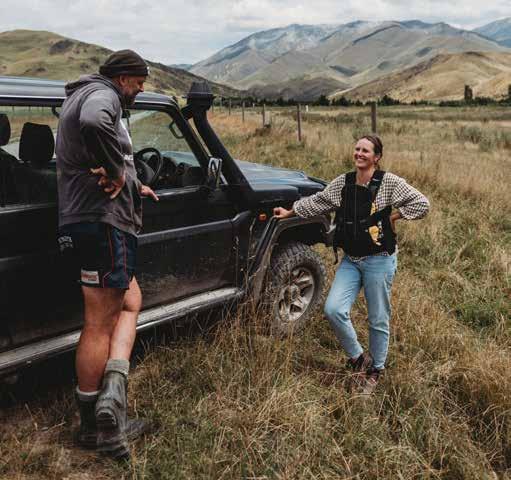
This is similar to how Dan grew up but his childhood had even less rules he says. “I was a wild little free spirit when I was that age. We are so lucky to be able to have the opportunity to bring our kids up like that, I know so many people don’t have the chance.
“We are very thankful to my grandfather Tom Fraser for buying the place, his three daughters (Alison, Zoe and Pam) for keeping the place going with the help of managers after Tom's passing, and for gifting their shares to our generation.”
18 | Farmlander | farmlands.co.nz
As guardians of the land Jaz and Dan try to include as many sustainable practices as they can to ensure the station is around for future generations.
Comfort and performance in all seasons.
Developed specifically for New Zealand conditions, Quatro gumboots by Skellerup deliver unrivalled comfort and performance.



Suitable for all terrains, Quatro gumboots are expertly handmade using natural rubber for ultimate durability and longevity. Ergonomically designed, Quatro gumboots give optimal all-day comfort with heel and arch support.
Thanks to multi-layer insulation and cushioned rubber midsoles, your feet will stay warm and dry even on concrete and in freezing temperatures. The tapered mud-release sole gives exceptional grip on any surface, while insulated and light options cater to every weather condition.
Find your perfect fit with Quatro.
SIZES AVAILABLE 2-14 M / 4-11 W

SCAN TO FIND OUT MORE ON THE FARMLANDS WEBSITE
FROM SEED TO FEED
From tiny seeds full of potential, to fields upon fields of lush crops, grazed upon by hungry livestock, Farmlands is there every step of the way when it comes to the seed to feed circle of life.
WORDS BY AYLA MILLER ELISE RUTHERFORD & JAMES JUBB
For much of Farmlands’ feed, it all starts on an arable farm much like Barnett Partnership's lot in Leeston; a town on the Canterbury Plains in the South Island of New Zealand. On 340 hectares Alastair and his brother Rob – both third-generation farmers – grow a combination of small seed crops such as clover and ryegrass as well as produce like broad beans, green beans, and peas for Watties. They also grow maize for the dairy industry, some triticale for seed, malting barley and have recently been getting into more vegetable seeds like radish, Asian cabbage and beets.
On farms like this, everything is geared towards having a bountiful harvest time which always starts in January and can go through until early April for the later crops like maize, radish and beans. While urbanites rejoice
in their summer break, Alastair and his fellow arable farmers set to work, literally reaping what they have sown.
Together he and Rob grow around 60-70 hectares of feed wheat which mostly goes to the dairy, poultry or pig industry and is largely sold through Farmlands.
“It can either go from farm to farm or a big percentage of it goes to Farmlands’ mill in Rolleston,” he says.
“I think there is a trend to go for more balanced feeds for stock rather than mono grain kernels which is probably a good option for improved animal health and therefore stock production, but it’s all dictated by expense and cost on the end product.”
To sell to Farmlands, arable farmers must meet a certain standard and abide by a list of specifications.
“For wheat it’s a basic list of requirements such a moisture levels
and quality, being limited screenings, good test weight and clean, free from weed seed and insects,” he says.
The Barnett's relationship with Farmlands goes over 30 years back to when it was Combined Rural Traders (CRT) which is why it was an obvious choice to supply to the co-op.
“It’s a long-term relationship that has been ongoing. The best way for a co-op to be successful is to get all their shareholders to support them and we support that model. The agents we deal with are very good and very supportive of us and we work well together and as a team – aiming to produce the highest quality product with the least environmental impact”
He says it also helps that across-theboard Farmlands is paying either market or good prices throughout the year.
Once harvested, the grain is sent to mill. In Alastair’s case he supplies
20 | Farmlander | farmlands.co.nz
Ayla Miller follows the journey from field, to mill, to farm.


farmlands.co.nz | Farmlander | 21 THE BIG PICTURE | Seed to feed
Canterbury-based arable farmer Alastair Barnett oversees the first stage of the seed to feed journey.
to the Rolleston Mill which can process up to 10 tonnes of grain per hour. Farmlands operates two mills, the one in Rolleston and another in Winton, Southland. These two mills produce a wide variety of feed options, ranging from bagged equine and poultry feed, to bulk custom dairy blends.
Both mills utilise shareholderproduced grains and legumes and

together with the help of Farmlands On-Farm Nutrition Specialists, play an important role in ensuring livestock farmers have support in selecting the right products and diet and the right nutrition for their animals.
From around November through to May a nutrition specialist will visit farmers and organise the contract for the season which can last 6-12
months depending on what the farmer needs based on the specialists’ recommendation for a specific diet.
Once a nutrition specialist has advised a farmer on their needs, a contract is written up and orders are placed at the mill.
Lincoln Dearden is Mill Manager at the Farmlands Winton Feed Mill where he has worked for the last three years. Prior to this he worked in the animal tanning industry but “jumped at the opportunity” to take on the role of mill manager. He is in charge of around 10 workers during the peak season and closer to six during the quieter periods.
The milling process begins when the raw commodities arrive at the mill off the arable farms. From here it goes into silos and is stored for a period of time before it is turned into feed by being processed through the mill.

Feed orders are received from Support Office detailing the contracts made with farmers and these are predominantly made on the day of delivery.
“We don’t really make any bulk feed in advance, only up to one day before, and there is a specific diet reccomended to the client, so we make to those diets,” Lincoln says.
22 | Farmlander | farmlands.co.nz
Raw commodities are stored in silos for a period of time before being processed through the mill and turned into feed.
The most satisfying part of the job on a daily basis is “making sure we have delivered everything on to the farms” he says, as well as working alongside his team.
“The guys I work with are great. They have a lot of experience in the industry so they can make your day a breeze by knowing exactly what they have to do without always needing instruction. It’s a small team and a good team to work with and, being in Southland, it’s not too busy around the roads for our delivery trucks.”
The Winton Mill press processes around 6-7 tonnes an hour, meaning it can produce anywhere up to 150 tonnes in a day depending on the
season demands, and supplies around 30-32 farms currently.
“Some of those farms in their quieter period might go to crushed wheat or they might just go to palm or DDG feed so it’s not all-year-round delivery from us, and comes back to their feed rate demands.”
Typical feed is made up of a mixture of barley, wheat, salt, magnesium and lime, mollasses and steam are added at the pressing stage where it is pressed into six millimetre pellets

and 10 millimetre nuts. From there it is transferred into the Auger truck and transported to the farms.
“We also have commodities such as distilled grains, palm kernel or soya that goes out onto the farm,” says Lincoln. “This just depends on what the nutrition specialist has advised for that farm.
“Generally farms do have a mixture,” he adds. “It also depends what the demand is for milk solids and the like, so they [the nutrition specialists] will put together a

farmlands.co.nz | Farmlander | 23 THE BIG PICTURE | Seed to feed
Lincoln Dearden, Mill Manager at the Farmlands Winton Feed Mill, with a handful of processed pellets destined to be a nutritious meal for livestock.
The most satisfying part of the job on a daily basis is “making sure we have delivered everything on to the farms”.
combination of pellets, crushed wheat and palm kernel or distilled grains and that all goes out to the farm as per what the recommendation is. It’s up to the nutritionist to adjust that diet.”
He says the bulk of the diets are made up of barley and wheat and adjusted depending on what the harvest for that season has been like.
Once the pellets have been pressed they are loaded into Farmlands’ own Auger trucks and delivered to local farms.
One such farm is Hennie and Gea Amtink’s 300 hectare farm where they run 1,000 dairy cows near Waituna Lagoon, along with their son Ard and two farm workers.

Hennie and Gea have been farming this land for 22 years and get bulk calf meal delivered by Farmlands trucks from the Farmlands Winton Feed Mill.
They begin feeding their calves a Calf 2000 early ween pellet before moving
them onto a 16 percent calf pellet when they are older. This is a barley wheat mix with certain percentages of salt, calcium, magnesium. For lactating dairy cows, Hennie uses dairy extra pre-calver nuts which have “extra goodies” such as soya and palm kernel for added nutrients.
Hennie says it is beneficial to have the support of Farmlands nutritionists who are able to assist in selecting the right feed for the right time and he appreciates that the grains his animals are fed are locally grown as “it doesn’t have to travel as far and keeps the cost down” while supporting other farmers just like him along the way.
Chris Stephens, Farmlands Team Lead for Nutrition, says his
team is a “useful tool as part of our shareholders Farming Business”.
“We provide a range of feed solutions for our shareholder. Straights, blends and compound feed from sites across both islands. [The team] are technically trained to ensure our shareholder’s farming targets are being met,” Chris says.
“We can provide market leading products and technical service across Dairy, Calf, Sheep and Deer operations supported by our Farmlands Technical Team.”
Throughout the Farmlands seed to feed journey, Kiwi farmers are empowering other Kiwi farmers to lead the industry towards a better, profitable and sustainable future.
24 | Farmlander | farmlands.co.nz
“We provide a range of feed solutions for our shareholder. Straights, blends and compound feed from sites across both islands.”
At the other end of the process Hennie Amtink gets ready to feed his dairy cows.
MUCH MORE THAN GRASS
Superior pastures are underpinned by science, knowledge of different farm systems, environmental factors and differing soils to bring cultivars that will add value on farm so every paddock performs. That's what goes into the making of these Elite prepacks.

Maxsyn NEA4 prepack
DIPLOID PERENNIAL
Delivers strong persistence and superior growth, with an animalfriendly endophyte.
• Maxsyn NEA4 has proven high yield and offers strength in summer and autumn. Superior tillering through summer helps persistence, and improves autumn growth, while providing extra warm season feed when needed. The difference is visible. Maxsyn retains its colour longer into summer conditions.
• Maxsyn is densely tillered and provides easy grazing in spring. The development of new tillers for the coming season ensures persistence and yield. NEA4 endophyte provides insect control and staggers free pasture.
• This Pack contains the high performance white clover combination of Kotuku and Ruru. Kotuku is a large leaved, fast
establishing white clover with exceptional yield, and Ruru is a new medium leaved white clover delivering more energy and protein in summer, plus extra nitrogen fixation too.
Maxsyn/4front mix
DIPLOID/TETRAPLOID PERENNIAL MIX
This Pack is a unique combination of tetraploid and diploid perennial ryegrasses, providing high palatability, density and persistence.
• Maxsyn and 4front are unbeaten in the Industry National Forage Variety Trials for diploid and tetraploid perennial ryegrass.
• 4front has high palatability so can increase animal intakes, animal performance and environmental outcomes. The addition of diploid Maxsyn increases pasture density and makes it more robust.
• Maxsyn contains NEA4 endophyte, and 4front NEA2, providing
superior stagger free animal performance and insect control.
• This Pack contains the high performance white clover combination of Kotuku and Ruru. Kotuku is a large leaved, fast establishing white clover with exceptional yield, and Ruru is a new medium leaved white clover delivering more energy and protein in summer, plus extra nitrogen fixation too.
Governor AR37 prepack
DIPLOID PERENNIAL
This Pack is a great all-rounder with proven performance across a wide range of farm systems, providing yearround yield and a robust, high feed value pasture.
• Includes Governor AR37 a fine leaved, dense and persistent perennial ryegrass proven as a great all-round pasture, with good spring and autumn yield. It's densely tillered and helpful in wet situations, offering soil protection against treading damage.
• AR37 endophyte is recommended for dairy, sheep and beef systems but not for pasture grazed by deer or horses due to the risk of ryegrass staggers.
• This Pack contains the high performance white clover combination of Kotuku and Ruru. Kotuku is a large leaved, fast establishing white clover with exceptional yield, and Ruru is a new medium leaved white clover delivering more energy and protein in summer, plus extra nitrogen fixation too.
For more Perennial ryegrass information and products, visit www.barenbrug.co.nz
In association with Barenbrug
farmlands.co.nz | Farmlander | 25
Rural economy braces for year of transition
With recession predictions rife and New Zealand farmers somewhat at the mercy of global events, pricing and demand, Farmlands Card Partner ASB shares a general market outlook for 2023 with a specific focus on the agricultural and rural sector.

26 | Farmlander | farmlands.co.nz
Looking ahead, 2023 is shaping up to be a transition year for food and fibre producers, ASB’s General Manager Rural Banking, Ben Speedy says (pictured left).
“With the backdrop of high commodity prices in 2022 and lower interest rates across the peak pandemic period, we have seen farmers repay record amounts of debt, increase on farm investment and extend environmental standards beyond compliance.
“Farm working expenses have increased significantly, and management decisions have favoured a focus on production, as these decisions have had profitable outcomes.”
Keeping in mind the predictions that New Zealand will enter a recession in the latter part of 2023, rising interest rates will likely result in a weaker household sector and softer global growth.
“Our economists see the economy contracting around 1 percent by mid-2024. That said, their expectation is that agriculture should fare better than its peers in construction, manufacturing and retail trade.”
The economic reopening of China is expected to help support demand for some New Zealand goods and commodity prices, however it is expected that stronger demand from China will likely be offset by weaker demand from elsewhere.
Trading partner growth in New Zealand is set to slow to 2.5 percent this year (compared to 6.3 percent in 2021 and 3 percent in 2022). Although China accounts for a third of New Zealand’s exports it plays an important role but it is not the only one Ben says.
As for staple industries like beef and dairy, ASB predicts these will outperform higher-end foodstuffs, as well as forestry products (given weak construction activity around the world).
“Renewed depreciation in the NZD will hopefully offset some of the drop in commodity prices, though it might have further to rise in the near-term given the rise of the Yuan and the aggressiveness of the RBNZ,” says Ben. “Fortunately for dairy farmers, Fonterra is nearly fully hedged for the current season and one-third hedged for the next one.”
While inflation may not have reached its peak yet, ASB expects it to remain more than 7 percent during the first part of 2023. “This means the RBNZ will need to front-load more OCR hikes to get it under control –we’ve pencilled in a 5.5 percent OCR peak,” Ben says.
“The good news is that farmers are entering the current trough in a much more resilient position than in previous downturns. Total dairy debt is down 15 percent from where it peaked prior to the pandemic, with the proportion of non-performing or stressed/watchlist loans at a sevenyear low south of 5 percent.”
He adds that there will also be greater clarity on the pricing of agricultural emissions this year.

will put pressure on demand for higher value food items “but population growth, a rising middle class and continued global supply constraints will sustain commodity values”.
In terms of what farmers can do to prepare, Ben says with the reduction in farm working expenses expected to lag the reduction of incomes, management decisions will need to have a greater focus on profitability rather than production, while the minimum rate of return required on a project or investment will need to increase to reflect the increase in interest rates.
“Understand your numbers and sensitivity to production variability and rising interest rates. At this point of the year, most expenditure is spent or accounted for. What becomes most important is the management decisions you make for the following season, primarily around your optimal farming system for the current economic environment.
“From an interest rate management perspective, understand what interest rate you can live with before losing sleep. If you are getting close, fixing may be a good option.”
“While this will have little impact on 2023, formulating an emissions mitigation plan will become a key management consideration for future years, or sooner for those wanting to participate in growing demand for carbon neutral and sustainably grown products.”
As for what will remain the same, Ben says the world still needs to be fed and people are more aware than ever of food supply challenges which
Working closely with and supporting rural clients across New Zealand for 30 years, ASB and its specialist Rural Managers are deeply entrenched in their local communities and have the knowledge required to make local decisions.
“At ASB, no two farms are the same; our team provides tailored guidance and advice to enable our customers to achieve their goals and long-term business sustainability.”
farmlands.co.nz | Farmlander | 27 THE BIG PICTURE | Market outlook
“The good news is that farmers are entering the current trough in a much more resilient position than in previous downturns.”
SOWING THE SEED
work underway and charts the progress and projects within the strategy to achieve a more productive, sustainable and inclusive economy over the next decade.
One of the goals is to add $44 billion in export earnings over the next 10 years with a focus on creating value. According to the 2022 Situation Outlook for Primary Industries (SOPI) there have been record exports for the sector of $52.2 billion and it is on course to rise to $56.8 billion in the year to June 2026.
BY AYLA MILLER
Looking internationally, there are a number of profitable options for New Zealand farmers looking to diversify and supplement their income with operations outside their usual field.
Steve Penno, MPI’s Director of Investment Programmes, says MPI supports problem-solving and innovation in New Zealand’s food and fibre sector by co-investing in initiatives that make a positive and lasting difference.
“We do this through the Sustainable Food and Fibre Futures (SFF Futures) fund which was established in October 2018. This can include: an opportunity for a brandnew product; a new way of tackling a pest or environmental issue; an innovation that transforms by-products into highvalue products; improving animal health or welfare.”
To support and accelerate the sector, MPI has released a road map called Fit for a Better World which sets out the
Sustainable Food and Fibres Future has a budget of $40 million per year and provides a gateway for entities to apply for investment in a range of projects that deliver economic, environmental and social benefits.
“The SFF Futures fund supports projects that drive innovation and help us grow sustainably,” says Penno. “It’s a co-investment fund with industry and supports projects from all over New Zealand.
“More than 230 projects had been funded as at November 2022. The total value of projects (Government and industry investment) is more than $529.4 million. Government investment to date is more than $245.4 million.”
According to MPI’s most recent Economic Intelligence Unit (EIU), onions have proven to be a staple ingredient for many cultures and cuisines around the world and the New Zealand industry has seen considerable growth over the past two decades.
World demand for fresh onions has seen continuous growth over the last decade, with most consumption taking place in Asia Pacific.

28 | Farmlander | farmlands.co.nz
With global food demand on the rise and gaps in international markets, Kiwi farmers are looking at ways to diversify outside of their core industries. We look at what’s trending overseas and what help is available for farmers looking to mix things up.
WORDS
In the future, demand for onions is expected to grow rapidly in Vietnam and Indonesia as more consumers have switched to home-cooking following Covid restrictions and health concerns.
While imported onions only account for a low proportion of total consumption in Indonesia, Thailand and Vietnam, the demand has increased, and this upward trend is expected to continue as a result of a growing middle income and urban population in these countries.
The demand for avocados has also risen following the infamous Australian newspaper columnists’ article that sparked a multi-generational debate. New Zealand’s avocado industry is growing and has been successfully exporting the fruit mostly to Australia.
Recognising the rising popularity of the fruit, MPI’s EIU investigated further opportunities, identifying several key markets in Australia, South Korea and Taiwan.
South Korea and Taiwan have seen a surge of avocado imports over the last 10 years due to a rising interest in imported fruits among the younger population. This is expected to increase over the next five years.

Hemp is another growing market across the globe providing New Zealand farmers with more opportunities. Despite the industry still being fairly new, governments are supporting its development to drive growth and expansion and investing in research of innovative ways to use hemp.
New Zealand is well suited to growing hemp in areas with a high availability of water as industrial hemp requires significant amounts of water to grow.
Demand for industrial hemp products is largely from high income western countries such as the USA, Europe, Canada and Australia and this is expected to continue
into 2030. Demand is also growing in Asia due to China’s role in the fibre market and the diverse applications of hemp fibre in industrial uses.
Some recently announced projects to receive support from the SFF Futures fund include:
Project Nautilus, a $16.8m partnership led by Mt Cook Alpine Salmon Ltd to develop a prototype for New Zealand’s first sustainable, land-based salmon farm.
The former Ocean Beach Freezing Works in Bluff is home to a pilot project which is evaluating commercial land-based whitebait farming.
MPI is partnering with 26 Seasons Ltd through SFF Futures to identify the most cost-effective method to grow high yielding, out of season strawberries using a controlled environment growing system.
Mushroom of immortality approved by Environmental Protection Agency
A fungus known as the mushroom of immortality has recently been approved for cultivation in New Zealand following an application by Alpha Health Care NZ Limited.
Harvested and used in traditional Chinese medicine for more than 2,000 years, Ganoderma sichuanense is believed to boost the immune system and helps to treat depression and high blood pressure.
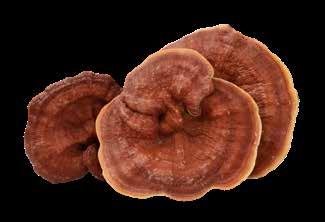
Traditionally collected from forests or grown on farms, Alpha Health Care NZ Limited

applied to cultivate the organism in industrialsized fermentation vats, or bioreactors. No mushrooms or spores develop during this process and only the relevant molecules, called fungal polysaccharides, will be extracted, purified and dried for use in health products.
Miriam Robertson, New Organisms Manager, says the EPA’s risk assessments found it unlikely that the fungus could escape or harm people or the environment given the strict rules in place for this set up.
potential economic benefits from cultivating this organism," she says. The health supplements produced will be for both domestic consumers and export, tapping into a global market for supplements made from the fungus.
farmlands.co.nz | Farmlander | 29 THE BIG PICTURE | Sowing the seed
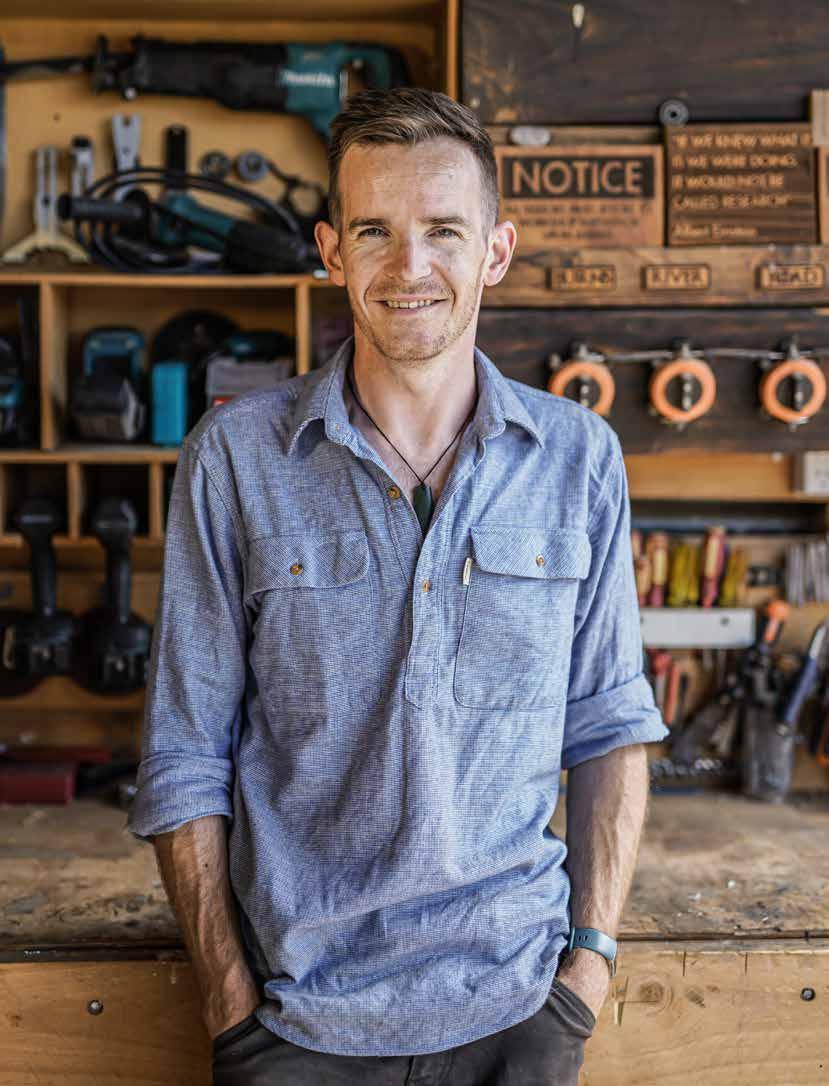
30 | Farmlander | farmlands.co.nz
Rob Swatton in his Montana Flat innovation hub.
ROBOTS take farming ‘back to the future’
WORDS
While cutting-edge technology such as robotics and AI will have a huge impact on how we farm in the 21st century, Future Whenua Co-Founder Rob Swatton believes the farm of the future could have a familiar feel to it.
Based on the 1,000ha Montana Flat sheep farming station in Southland, Future Whenua is an emerging agricultural innovation hub, looking to bring new tech and new ways of thinking to the ever-evolving sector.
Rob, who launched the project with third-generation Southland farmer Zeb Horrell shortly before the Covid-19 pandemic, says there is an old-school feel to some of the ideas being explored.
“We have a laser engraving of a DeLorean in our office, because it really is ‘Back to the Future’; we are combining newer technology with some earlier techniques,” he says.
“If you go back 150 years, you had a much more diverse crop, with a range of crops being grown alongside each other on the same farm. If we can use large-scale robotics and AI to gather data and deliver nutrients to individual plants, we could see this method of farming become viable again.”
The role of technology in farming’s future will be one of the hot topics
at the upcoming Future Whenua Summit 2023, which will take place in March and feature a host of local and international speakers.
Now in its third year, the event is back home at Montana Flat, after a successful outing at Mangarara Station in the Hawke’s Bay in 2022 under Covid restrictions.
Tickets to the event will be free, but attendees will be asked to consider koha (donations). Last year’s Future Whenua Summit broke even and Swatton is hoping to see a bumper attendance this year now that pandemic restrictions have been dropped.
He expects some “radical” ideas to be discussed at the conference but he says out-of-the-box thinking will be needed to help New Zealand farmers overcome mounting challenges, including supply chain disruptions, land use/environmental issues and labour shortages.
“I understand things can take a long time to switch but there is often an element of inertia,” he says. “Usually there is about a 50/50 split between there being a good reason for doing something and doing it because everyone has done it this way for so long.”
Born in the UK, Rob developed an affinity for farming as a child, when

a friend’s family became pioneers in organic farming. His interest in farming was rekindled after moving to New Zealand, where he worked for a rural TV show. This was one of many jobs he held, including high-altitude tour guiding, before he found a home in the tech sector working with robotics.
“My background is quite varied: I did 33 jobs before realising I was a terrible employee,” he says. “In New Zealand you can rock up to a place and if you don’t go away for a while, they will probably give you some kind of entry-level job.
“My problem is that when businesses ask for innovation, they usually mean ‘within boundaries’.”
Boundaries are not in clear evidence at Future Whenua. Current projects include creating 3D printed houses made from biomass, building a robotic weed control system that can spray individual trees, and creating a waste-to-energy solution that can turn farm waste into a gas usable for generators while also breaking down harmful toxins.
Rob acknowledges that most of these projects are years away from being commercially ready, a challenge that faces many Kiwis in the rural sector with creative ideas.
farmlands.co.nz | Farmlander | 31 THE BIG PICTURE | Future farming
Our hi-tech future may look more like River Cottage than The Terminator, if a robotics expert’s vision for New Zealand’s farming sector comes to life.
BY NIKO KLOETEN JAMES JUBB
He says by basing the campus on an active farm, Future Whenua aims to support ideas that fall in the gap between results-hungry venture capital and the slower-paced world of academia.
“Too many ideas die on the vine because they haven’t figured out the business case yet. There just isn’t the capital pool in New Zealand to support ideas that might take three to five years to develop, and this is forcing too many people overseas.”
Rob is hoping to bring the tech sector’s love of trying new ideas over to the farming world. He says his
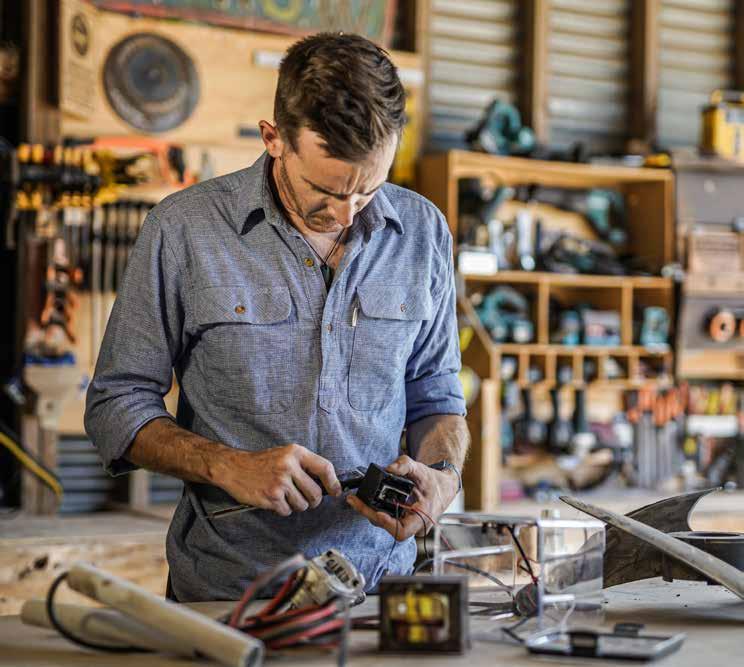
co-founder Zeb’s practical farming experience offers him the perfect foil when proposing solutions.
“The way farmers look at a problem now is by asking: ‘How does a human pick a piece of fruit?’ Why don’t we ask: ‘How we can grow the orchards in a way that works with the technology?’
“The tractor was just a mechanisation of the beast of burden, performing the same function as the ox and cart but better. Over time we have just made the tractor bigger. By asking how we can make it 10 percent more efficient, we have worked ourselves into a corner.”
Future Whenua Summit 2023
Future Whenua Summit is an innovative 3-day educational event bringing together people and ideas from across the rural sector.
When: March 17-19
Where: Montana Flat
More info: www.futurewhenua.co.nz/ fws2023
32 | Farmlander | farmlands.co.nz
“Usually there is about a 50/50 split between there being a good reason for doing something and doing it because everyone has done it this way for so long.” – ROB SWATTON
HONDA OUTDOORS IS HERE...
GENERATORS LAWN CARE






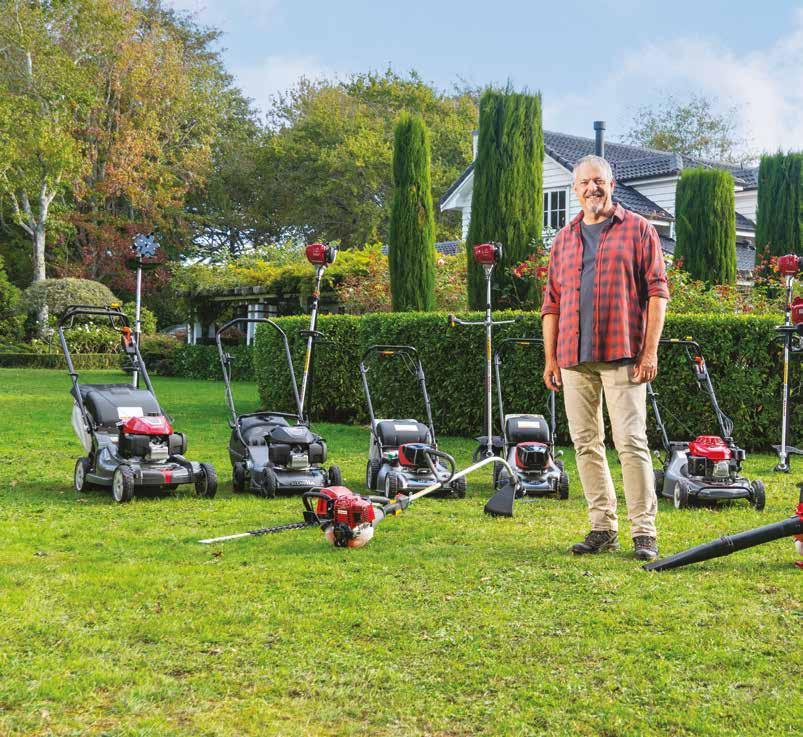
PUMPS
Honda Outdoors is here, bringing together the full range of Honda Outdoor Power Equipment all under one roof. For over 50 years Honda has provided generations of Kiwi farmers with products to help keep their operations running. Use your Farmlands Card at your local Honda Outdoors store to purchase power equipment and get access to genuine Honda accessories and servicing*.
*Terms & Conditions apply. See farmlands.co.nz for more information.
ENGINES + MORE
hondaoutdoors.co.nz
With a growing number of thriving agricultural operations being run by Māori authorities across Aotearoa, Farmlands is setting out to better understand how it can support and assist these businesses with its products and services. We speak to Farmlands Cultural Advisor Thomas Rawiri to find out what this looks like.

34 | Farmlander | farmlands.co.nz
WORDS BY AYLA MILLER ROBIN HODGKINSON
Thomas Rawiri on his iwi land at Maungakiekie One Tree Hill, Tāmaki Makaurau Auckland.
According to Statistics New Zealand in 2021 (the most recent statistics available at the time of writing) there were 1,227 Māori authorities in Aotearoa. Around a quarter of these operated in primary industries.
To ensure Farmlands is well equipped to support this growing part of the ag sector, Thomas Rawiri (Ngāti Paoa, Ngāi Tai ki Tāmaki, Ngāpuhi Te Aupouri), Cultural Advisor for Farmlands, has been appointed to work on building relationships with Iwi-run agricultural operations.
“The treaty settlements process has seen the return of ancestral land holdings for many Iwi, providing some capital, which they are able to utilise to explore agricultural opportunities,” he says.
“Māori have a deep and intrinsic relationship with land and water, encompassing mātauranga/knowledge and traditions that go back centuries.
“At the time of European settlement Iwi and hapū across Aotearoa were at the height of their agricultural prowess, with vast areas of land utilised for agricultural purposes and much of the day-to-day life centered around traditional practices that sustained both people and the environment.”
Due to significant land loss and colonisation, the Māori way of life changed significantly, and is only beginning to recover now.
“The knowledge and traditions remain through the practice of kaitiakitanga, a cornerstone value of the Māori approach to agriculture and land management. Coupled with contemporary tools and technology the Māori Agricultural sector continues to grow rapidly, with diverse and innovative methods and products being developed and explored for both domestic and international artists.”
With Māori authorities exporting $872 million worth of goods in 2021, this sector is also becoming a major contributor to New Zealand agriculture’s Gross Domestic Product (GDP).
A combination of the corporatisation of Iwi entities, and with more resources now available, the scaling of these operations is happening rapidly.
“There are lots of whānau trusts and smaller trust entities or landholding trusts

that are now conglomerating pieces of whenua to create bigger entities, in order to leverage opportunities in the sector,” Thomas says.
As part of Farmlands’ work to better serve its customers and provide meaningful support, Thomas’ role as Cultural Advisor involves listening to the Māori ag sector and building relationships to foster meaningful engagement and support.
“Farmlands wants to really understand that space, to work and engage meaningfully with the Māori ag sector to understand their values, and their approach to agriculture in order to effectively respond to their needs and provide a better service,” he says.
“There is a bit of work we need to do to get the approach right in order to respond to where the Māori ag sector is currently and will be heading in the future.”
Part of Thomas’ work is to develop an engagement framework to guide how Farmlands engages with Iwi and Māori agricultural businesses.
“It’s all about relationships, part of that is actually going into their space, going onto the marae, engaging from a tikanga perspective and listening to them, hearing their stories, understanding the journeys they’ve been on to get to where they are today and then formalising an agreement based on mutual respect for each other’s values,” he says.
“How can we be there to help and support them achieve their goals, their aspirations and what services and products do we have that can support and encourage them and their vision for the future.”
A key part of this is understanding that Iwi farming is not centred around profit, Thomas says.
“It’s centred around leaving the whenua (land) in a better condition than we found it and future proofing it.”
With 70 percent of Māori authorities very aware of the potential impacts of climate change (Stats NZ 2021), it is clear the concept of kaitiakitanga or guardianship is a core value still held by many Iwi-run agricultural operations.
Another key to understanding Māori agriculture is through traditional mātauranga Māori, and applying
traditional knowledge systems in the modern-day context says Thomas.
“Mātauranga Māori helps to inform many things, when we plant crops, when we harvest, what is the best crop to plant or where to plant that crop.”
The concept of mauri or life-force is also important in traditional Māori agriculture. The essence of mauri can be transferred or enhanced, and Māori agricultural practices are focused on ensuring that it is not diminished and “understanding that the reciprocal nature of enhancing the mauri of a space will give back to us and enhance our own mauri and our own well-being,” says Thomas.
“It will be better for everyone and most importantly our taonga species, our native species to Aotearoa, which we have an obligation to maintain, enhance and protect.”
It's also important to remember that each Iwi is different and holds their own tikanga or customs and practices Thomas adds.
“Our landscape is very diverse. So, one area might be better suited for dairy farming, another might be forestry, another might be better for growing fruit and vegetables.”
Ultimately it all comes back to the Te Tiriti o Waitangi principal of Tino Rangatiratanga or self-determination, Thomas says “for Iwi to determine that for themselves”.
“That self-determination for Iwi to make those decisions and to determine their own pathway based off their traditional and local knowledge.”
And the future of the sector is looking bright as a new generation of young adults enter the workforce having grown up “walking in both worlds” says Thomas.
“Understanding mātauranga Māori (traditional knowledge) and the mātauranga Pakeha from a scientific perspective and using those tools to develop awesome new products or approaches. I think that’s a really exciting part of the sector.”
farmlands.co.nz | Farmlander | 35 THE BIG PICTURE | Māori agriculture
Get in touch with Thomas at Thomas.Rawiri@farmlands.co.nz
MEETING YOUR ENERGY NEEDS
for our country, and Strategic Card Partner Meridian Energy is here to put on the gumboots and walk alongside them to support them where they can.
Caitlin Donnison is one of Meridian Energy’s Agribusiness Account Managers based in Christchurch, supporting customers in the rural sector across Aotearoa to meet their energy and sustainability goals. Here, she shares insight into the energy providers’ Certified Renewable Energy product:


What do you think are some of the biggest challenges facing farmers in New Zealand when it comes to their energy needs?
Some of the biggest challenges facing farmers is how they can best use their energy to tackle key issues affecting the rural sector. Specifically, how to create high quality products with the lowest environmental impact during production
and have a lower carbon footprint. A key challenge is how farmers can meet sustainability goals, in a way that is financially sustainable too.
What is Certified Renewable Energy?
It's a product that enables Meridian’s business customers to match the amount of electricity they use on an annual basis, with an equivalent amount of electricity put into the national grid from one of Meridian’s hydro stations or wind farms –independently verified as producing 100 percent renewable electricity. It allows businesses to report their market-based scope two emissions linked to their electricity usage as zero (using the market-based reporting methodology as per the GHG Protocol’s Scope 2 Guidance). Certified is delivered through
renewable energy certificates (RECs) which, are a practical alternative to carbon credits for those who may already be offsetting their GHG emissions or are thinking about it.
Why is Certified important to Meridian?
Meridian introduced Certified as a direct response to customer requests for us to support them to achieve their business and sustainability goals. It can help build a business’ reputation, strengthen their brand, and enhance stakeholder relations.
Why is this type of energy significant in a rural/farming setting, why should farmers take note?
There are changing consumer trends both locally and internationally, where the public is more conscious of where products are sourced and the social and environmental attributes of suppliers. By demonstrating a commitment to sustainability and renewable energy generation, farmers show their support for decarbonisation nationally and within their local communities. Meridian reinvests the net proceeds from Certified into projects – like the deployment of EV chargers, electrification of process heat and installation of solar panels – that help Aotearoa decarbonise in tangible ways.
36 | Farmlander | farmlands.co.nz
The agricultural industry is full of farmers already doing great stuff
Caitlin Donnison.
GROWING a generation of farmers
Young farmer Aimee Blake is empowering a new generation of women to follow careers in the primary industries.
WORDS BY BERNADETTE BASAGRE
As a sixth-generation farmer, Aimee Blake has always been interested in the world of farming and considers food her love language. It is because of this that she made the decision to follow in her family’s footsteps.
“I sort of ended up coming to realise that food and food systems are so important. They shape us, and they shape our world,” says Aimee.
“I decided that actually this is what I want to do and food, for me, is love.”
Passionate about a healthy future for farming in New Zealand, it seemed a no brainer for Aimee to work alongside other like-minded farmers to create initiatives that empower the next generation in the primary industries.

As a Co-Chair of Future Farmers, Aimee and a diverse group of 25 have created a manifesto for the government based on a healthy future, with 2023 being the year of action.
“Future Farmers is all about bringing a youth voice to the table and making sure that you're really heard and considered,” she says.
But the passion to grow the younger generation of the primary industries doesn’t stop there for Aimee.
Ministry of Primary Industries has stated that the industry needs 50,000 new workers by 2025, but only six percent of school leavers enter the industry, and it has been decreasing since 2009.
“We also came to find that women are significantly underrepresented,

holding only six percent of governance roles and there's just no real career narratives, especially for young urban women,” she adds.
Realising the missed opportunities, especially for women, Aimee decided to create Girls Who Grow.
“We entered to sort of ideate around this problem that young people really don't see a meaningful career pathway into agriculture in our primary industries,” says Aimee.
“Girls Who Grow mission is to grow and inspire the next generation
of female change makers, leaders and environmental guardians. Essentially what we're doing is we are changing the narrative; we're reconnecting young women back to our landscape.”
Through Girls Who Grow, the initiative will introduce the career options in farming to high schoolers through educational workshops, lunch and creative experiences at farms.
“Activating those future farmers, through New Zealand key principles in an interactive way and also built on a foundation of Te Ao Māori and our indigenous wisdom, which is really, really important for a sustainable and enduring relationship with our future landscapes,” she adds.
2023 is considered the year of action for Aimee, as she hopes to scale her reach within the younger generation for both Future Farmers and Girls Who Grow.
Girls Who Grow will begin their crowdfunding campaign and hope to get partners this year.
“We want to continue our policy work, really start advocating and also do some educational stuff too.”
Passionate about the primary industries, Aimee says that 2023 is the perfect time to show what opportunities the farming industry has for young Kiwis.
To find out more, visit www.girlswhogrow.co.nz
farmlands.co.nz | Farmlander | 37
THE BIG PICTURE | Profile
Aimee Black.

38 | Farmlander | farmlands.co.nz
Joe from The Common Good Hunters Trust.
DEER TO BE DIFFERENT
Since Joe Morrison got hooked on deer hunting just five years ago it’s fair to say he “caught the bug”. A strong believer in only shooting what can be consumed, he has found a two-pronged solution for wild deer eradication and passing it on to those in need. He talks to Alice Scott about his newly established charitable venture.
WORDS BY ALISON SCOTT BAILEE RUEBEN
Founder and CEO of a software company in Dunedin, Joe Morrison enjoys spending his weekends out of the office and in the hills, hunting wild deer in the Otago region.
“I love being outside and in big country. There’s a technical side to hunting which I really enjoy,” he says.

To Joe and his hunting companions, the end result of every successful hunt is to bring the meat home for them and their family to enjoy.
“To us, it’s important that every deer shot, is carried off and processed to be eaten. What we were finding was that we were shooting more than we could consume, which seemed like a real shame when there are people who don’t have the means to buy meat like venison. When I hear about game that has been shot and left behind by hunters it’s quite heartbreaking when there are people in our local communities that don’t have access to good-quality red meat.”
As a solution to this problem, Joe founded The Common Good Hunters Trust. A registered non-profit organisation providing venison to charities in need. “The Trust was established to achieve two outcomes: to help feed those in need by donating red meat to charities who provide meals and to minimise the wastage of quality meat when feral deer culling is required.”
The first hurdle was to ensure the concept was a legal and viable option with the Ministry of Primary Industries. “The legalities of supplying home kill meat is that there is no financial gain or bartering.”
The second step was approaching organisations to see if wild venison was something they would happily take and pass on to those in need. “I approached the Dunedin Night Shelter Trust and St Vincent de Paul Food Bank and both were happy to receive the meat.”
To Joe, starting out small and taking it slow is important. “I have started a few companies over the last 30 years or so. You only get once chance to get things right. We are very aware of walking a fine line and reputation is extremely important. Health and safety and hygiene are very important to Joe and the team and the game that is killed is processed
Be considerate
The Common Good Hunters Trust works alongside hunters and farmers to ensure there is limited disruption on farm during hunting season. Hunters are urged to be respectful of farmers and animals when shooting.
farmlands.co.nz | Farmlander | 39
THE BIG PICTURE | Deer hunting
systematically. “We are very methodical so that every deer is processed in a consistent way and the end product is what the organisation wants.” Most of the meat is made into sausages and mince for ease of cooking and backstraps are served at the Night Shelter as steaks or roasted.
Joe said he and the small group of hunters that are part of the Trust to date, have no interest in shooting trophy stags and are aware there are certain times of the year when landowners do not want extra hunters on their land. “We tend to stay away during fawning and during the Roar when there are a lot of hunters out and about.”

While it’s still early days into the venture and Joe is in no rush to crank up volumes, he is keen to foster new working relationships with landowners who want to be part of this philanthropic movement. “Landowners who have a deer problem and are keen to see it go to those in need. I am not looking for one-off commitments but more an ongoing partnership with those that share the same values as the Trust,” he says.
Dunedin Night Shelter General Manager David MacKenzie said his organisation has been “blown away” by the venison deliveries. “It really changes up the menu and what we offer to people. Many of them had never tried venison before and many are in awe of such a nice meal and so appreciative,” he says.
FEATURED PRODUCTS
Rural Butcher Sausage
Filler 3L

Stainless steel, 4 different sizes of spouts.
$295.00
Rural Butcher Knife Fillet Set 2
Piece
Filleting Knife set presented in a convenient roll bag.
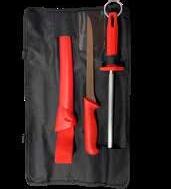
$69.95
Find in-store at Farmlands or shop online at shop.farmlands.co.nz
40 | Farmlander | farmlands.co.nz
MORE REASONS TO CHOOSE ALLFLEX
The wide portfolio of Allflex products ranges from calf ID tags from day-one use, through Tissue Sampling for disease eradication, genomic selection and traceability, to electronic identification (EID) solutions for cattle of all ages.
Allflex electronic and visual ID tags are available in matched pairs, combining the benefits of electronic identification with a visual tag, to streamline processing and accuracy.
Made from high-quality materials, Allflex cattle ID tags are uniquely designed for maximum animal safety and comfort, long-lasting durability and retention, easy application and readability.
Recently Allflex had the opportunity to install an ID tag wall at the brand-new Farmlands Ashburton store. Farmlands and Allflex have always enjoyed a strong working partnership, built on an unwavering dedication to provide farmers and shareholders with high quality products, technical expertise and solutions that make life on farm easier.

The Ashburton Tag Wall is just one example of how Allflex provides a point of difference for customers. This means that local dairy farmers can visit the new store for any dairy heifer replacement management tags numbered from 1-1000 off the shelf without the need to wait for printing.
Features
• The Allflex Male tag can be paired with any of the Allflex Female tag range
• Animal numbers are marked with our patented LaserPlus (jet black) marking, text and vertical year codes are laser marked
• Multiple marking options available including a wide variety of letter and number combinations
• Patented shape and swivel collar
• UV stabilised material.
Benefits
• Provides high visibility for the farmer when looking at the animal from the back
• The most visible and long-lasting identification print on the market for ID longevity
• Flexibility for customised on-farm identification management
• Our shape and stem design outperforms other profiles in both retention and durability. The swivel collar allows the tags to automatically find their center of gravity meaning it is less prone to snagging
• Designed to withstand New Zealand’s harsh UV conditions to ensure sustainability and avoid fading.
For more livestock intelligence visit www.allflex.co.nz
farmlands.co.nz | Farmlander | 41
For more than six decades, Allflex Livestock Intelligence has been a world-leading provider of visual and electronic identification solutions for cattle to support local identification and traceability requirements.
Chris Jennings, MSD Sales Lead – ID/OTC and Kane Chambers, Business Manager – Farmlands Ashburton.
In association with Allflex
With hunting season upon us and the prospect of more meat from home kills, the team at Silver Fern Farms have put together two simple but delicious venison meals to feed the family, perfect for those cooler nights.
Venison Medallions
with Redcurrant Jus
Serves 2-3 people
INGREDIENTS
1 pack Silver Fern Farms Venison Medallions
1 Tbsp olive oil
2 Tbsp red currant jelly
½ cup reduced-salt chicken stock
METHOD
• Remove Silver Fern Farms Venison Medallions from the fridge and packaging and allow to rest at room temperature for 10 mins.
• Toss the Venison Medallions in olive oil season to taste. Bring a frying pan to a high heat. Quickly pan-fry the Venison Medallions for 2-3 mins each side (medium-rare). Remove from pan, cover, and rest for 2-3 mins. Add the red currant jelly and reduced-salt chicken stock to the pan. Simmer and reduce until like a thick sauce.
• Drizzle the Venison Medallions with the juices from the pan; serve with oven-baked potatoes and seasonal vegetables of your choice. For optimal flavour and tenderness, serve medium-rare to medium.

42 | Farmlander | farmlands.co.nz
Saucy Cranberry Venison Burger
Serves 4-5 people
INGREDIENTS
1 pack Silver Fern Farms Venison Mince
1 Tbsp olive oil
150g goats’ cheese
4 Tbsp Greek yoghurt
½ lemon, juice of

1 red onion, thinly sliced
½ cup white vinegar
4 whole wheat hamburger buns
¼ cup cranberry sauce
1 Lebanese cucumber, sliced
2 Tbsp thyme leaves
Micro greens
METHOD
• Remove Silver Fern Farms Venison Mince from the fridge and packaging and allow to rest at room temperature for 10 mins.
• Place Venison Mince into a bowl and break up. Add 1 tsp salt and season with pepper. Wet your hands and bind.
• Blend the goat’s cheese, Greek yoghurt, lemon juice, salt and pepper together with a wooden spoon or high-speed blender. Chill. In a small glass bowl, combine the sliced onion and the vinegar. Allow to pickle.
• Heat a frying pan or BBQ plate to low-medium heat and add 1 Tbsp oil. Cook the venison burgers for 3 mins on one side then turn and cook a further 3 mins. Remove venison burgers from pan and leave to rest for 3 mins covered with foil.
• Return the pan to heat. Toast the bun, cut side down until golden. Remove from heat.
• Start with the bottom bun, spoon on cranberry sauce, top with venison burger, then a generous spoonful whipped goats’ cheese, cucumber and Arugula leaves. Finish with pickled red onions and top of the burger bun.
For more recipes and tips from Silver Fern Farms, visit www.silverfernfarms.com/recipes-and-tips

farmlands.co.nz | Farmlander | 43
THE BIG PICTURE | Recipes
Are you looking to get your garden ready for the colder months? TopmaQs range of tools and equipment has everything you need to clear leaves and debris, trim hedges and bushes, and prune trees. Our leaf blowers, hedge trimmers, and chainsaws are perfect for use in autumn, making your garden maintenance a breeze. We also have a range of logging equipment to help you get your firewood ready for those cold months ahead.
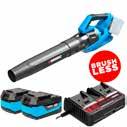





Don’t wait until it’s too late to start your winter prep! Trust us to provide you with the tools, equipment, and advice you need to make your garden thrive!


5 STORES NATIONWIDE • AUCKLAND • HAMILTON • CHRISTCHURCH • TIMARU • DUNEDIN ⛟ NZ DELIVERY ���� 0508 867 621 ���� WWW.TOPMAQ.CO.NZ MORE INFO: WWW.TOPMAQ.CO.NZ/FARMLANDS 700mm 9.75kw Petrol Log Cutter Firewood Saw LOCU1220 WAS $2,277.90 $1,999.90 SALE ENDS 31/5/23 SAVE $278 Speed 1,380 / 3,600rpm Blade 700 x 30 x 4mm x 42 teeth Cutting Capacity 200mm Log Cradle Width 300mm INCL GST Towable Petrol Wood Conveyor 5M LOHA1260 Constructed from heavy duty durable steel, this Platinum Pro conveyor operates using a 2.5hp 4-stroke engine, and is a powerful machine for moving your logs, wood and timber from one place to another. WAS $3,664.90 $3,298.41 FARMLANDS CARD EXCLUSIVE SAVE 10% INCL GST ALL PRICES INCLUDE GST - ADDITIONAL DELIVERY CHARGES APPLY OR COLLECT IN-STORE - SOME ASSEMBLY REQUIRED - DISCOUNTS ABOVE 10% EXPIRE 31/5/23 - FARMLANDS CARD EXCLUSIVE PRICING VALID 24/7 58cc Backpack Petrol Powered Leaf Blower LABV1350 WAS $399.90 $339.90 SALE ENDS 31/5/23 SAVE 15% Engine 2 stroke, air cooled Output Power 2.2kw/8000r/min Air Volume 0.3 m3/s INCL GST V-Style Cantilever Log Saw Horse LOHA2050 WAS $257.90 $219.90 SALE ENDS 31/5/23 SAVE 15% INCL GST 36v Li-ion Brushless Leaf Blower Combo Kit 4AH POBA9755 WAS $331.60 $315.02 FARMLANDS CARD EXCLUSIVE SAVE 5% “This product is arguably the most important powertool we use. It’s lightweight, instantly ready, and no downtime in the middle of jobs mixing fuels. It’s so good, I threw away my $1,000 Stihl blower!” - John INCL GST FARMLANDS CARDHOLDERS RECEIVE 5-10% OFF OVER 3000 ITEMS EVERYDAY

Autumn checklist


46 | Farmlander | farmlands.co.nz
PLAN TOMORROW, TODAY: Your practical guide to autumn farming and growing
This autumn Farmlands is getting behind farmers and growers in a big way by leaning into our technical and practical experience offering insight, advice and product options specific to your business.
We know the farming and growing calendar inside out, we know what's happening where and when. And we have the partners and suppliers on-hand, to deliver more than just price and product.
Farmlands is committed to partnering with you this coming season, to share the knowledge we have at our disposal and seek the best outcomes for your farm, orchard, vineyard or even lifestyle property, wherever you are in the country.
Over the next several pages you’ll hear from a range of our sector-specific experts who cover off a range of topics, including:
• Soil testing and fertiliser use
• Autumn re-grassing and winter feed
• Ensuring stock is healthy heading into the winter months

• Insight into the best and most nutritious diet for your animals
• Tips on how to make sure your calves have what they need even before they are born
• And much more…
farmlands.co.nz | Farmlander | 47
AUTUMN CHECKLIST
SHEEP & BEEF
Preparing for tomorrow, today
With increasing on-farm overheads and reduced revenue, Farmlands Agronomist Brian Richards says soil testing should be high on the priority list when it comes to sheep and beef farmers working out their agronomy plan for the season ahead.
WORDS BY ALICE SCOTT
“Sheep and beef farmers, North and South Island, will be thinking about nitrogen side-dressing for winter brassicas, autumn fertiliser maintenance program and an Autumn regrassing plan after summer crops, cereals,
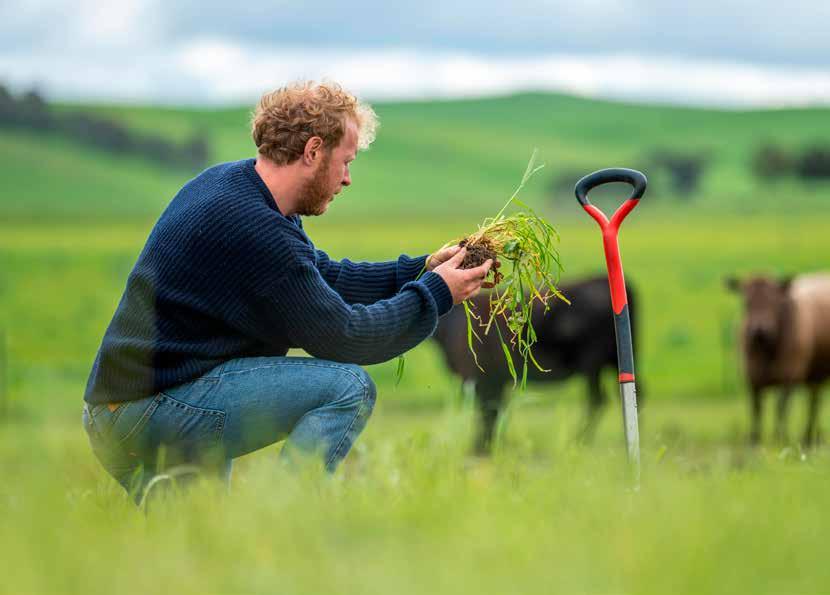
maize and run out pastures. Stitching in an annual, Italian rye or hybrid rye grass may also be on the cards for some who are thinking about ways to get older pastures through a season or two before going into crop or a perennial grass mix.” he said.
The costs for maintenance fertiliser is now what farmers would have paid for capital fertiliser inputs in years gone by. “The price tag for fert has more than doubled in recent times so now the agronomy conversation is around what paddocks we can get
48 | Farmlander | farmlands.co.nz
away with leaving and what needs to be prioritised. A soil test is always the first step and we work from there.
“Soil and herbage testing will also help with identifying what macro and micro nutrients are deficient in the soil and plants, these can be added to the fertilizer mix to address any deficiencies,” he said. “Healthy soil, healthy plant, healthy animals.”
“Some farmers are opting to defer paddocks for a year or drastically cut what was planned, knowing that they can get away with it for a season and then they’ll have to play catch up. Not the situation farmers want to be in but they need to work within their financial constraints.”
The summer was a high growth season for North Island farmers with plenty of supplementary feed cut and stored away. “Most are heading into the Autumn with plenty of stored feed and have options which is good,” he said.

UNDERSTANDING LIFE AT THE COAL FACE

Coming from a farming background, Farmlands Agronomist Brian Richards agrees he still thinks like a farmer, fully aware of the relentless list farmers are continually working through and the little time most will have for idle chat with salespeople.
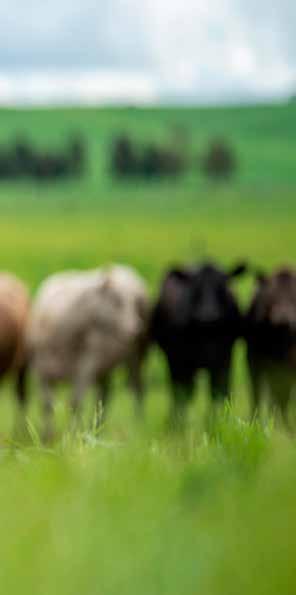
“I fully understand what life is like at the coalface and I do think that has been quite a key attribute to establishing good working relationships with shareholders and training our Technical Field Officers, (TFOs),” he said.
BRIAN RICHARDS FARMLANDS AGRONOMIST
Brian managed farms for Pāmu Farms (formally known as Landcorp) for 15 years and he was instrumental in launching the company’s Future Farmer Cadetship, a programme that ran for about 12 years.
He then worked in the live export market for five years, travelling frequently overseas and did a year in Uruguay with New Zealand Farming Systems Uruguay (NZSFU) doing dairy conversions. “Some of the experience was good, some not so good but that’s another story,” he laughs. Back home in New Zealand in 2010 and considering his next career move, Brian was out for a run when he bumped into a friend and was offered a job in retail at Farmlands Taupo. “I started in retail and pretty soon was a Technical Field Officer progressing to an agronomist with some key shareholder accounts and tasked with upskilling and training of TFOs. It’s been a crazy old ride, that’s for sure.”
Advising farmers on their agronomy during a time of financial uncertainty, legislation impacts on their farming enterprises and record high costs is a big challenge. “As agronomists, we are always striving to do our best by the farmer, but results are only ever going to be as good as what the farmer can afford to do. It’s working through the options and continually keeping our eyes and ears open to solutions for the betterment of our clients.”
Giving back to the land
Farmlands is committed to supporting farmers and growers to protect, restore and sustain our environment as we continue to face increasing environmental pressures and tougher sustainability goals. This autumn, Ballance and Farmlands are going further with our Trees for Tonnes initiative which contributes towards your long-term planning of riparian planting.
Buy over 30 tonnes you will get one native tree for every extra tonne of BAN fertiliser purchased through Farmlands.

Terms and Conditions apply. Promotional period 1st February – 31st May. Limit of 120 trees per shareholder.

farmlands.co.nz | Farmlander | 49 AUTUMN CHECKLIST | Agronomy
NURSERY
AUTUMN CHECKLIST
HORTICULTURE Support for success
During what’s been described as a challenging time for growers, Farmlands is always on-hand to offer technical expertise and product support to help growers and farmers better navigate the autumn months.
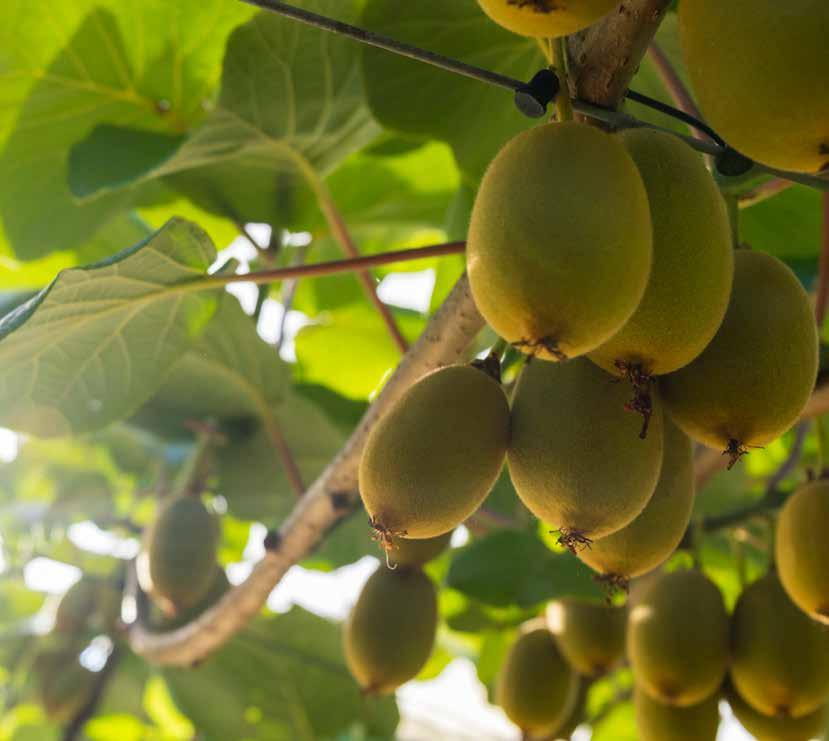 WORDS BY ALICE SCOTT
WORDS BY ALICE SCOTT
50 | Farmlander | farmlands.co.nz
Alot of activity is happening on orchard over autumn. And while timing between sectors and regions vary and most growers will know what they need, an in-depth understanding of the sector within the Farmlands technical team is invaluable to shareholders.
“We can help by making it as easy as possible for orchardists to access the products they need at the right time. We understand their world. Farmlands can provide the products, support and advice they need, when they need it,” says Nikki Almond, Head of Merchandise - Horticulture at Farmlands.
With growers continuing to face many challenges across all crop types, the extra issues the weather throws at growers are not helpful in maintaining wellbeing.
When the frost event hit the wider North Island in early October last year, orchardists in these regions faced additional challenges.
For kiwifruit growers in particular, it became apparent very quickly, there would be significant impacts to the industry. In fact, many viewed the event and the effect on its people as being like the initial impact of PSA,
with many fearful of the hit to their cashflow and continued viability of crop. See page 76 for more on this.

As it was in that situation, the Farmlands team was on hand to listen, understand and act. Using the combined long-term experience in the team, they took to orchards to aid in their understanding of the issue and by using wider contacts, formulate a strategy to aid the quickest recovery to the best levels available.
“The feedback from the industry highlights to us just how valuable our team can be and how critical good relationships are within what is a fantastic industry.
“Farmlands remains committed to horticulture and wishes growers every success in the year ahead,” says Nikki.
From a technical perspective, Mart Verstappen, Farmlands Technical Leader Viticulture says that post-harvest is the perfect time to ensure your plants are getting the nutrients they need prior to leaf drop and budbreak.
“Post-harvest is a critical time to apply soil based and foliar nutrition as vines actively translocate nutrients to the buds, canes, trunk and roots, to store these elements and
Plan for a successful budbreak with Advance Gold®
Farmlands supplies an alternative mode of action bud breaker for Gold 3 Kiwifruit that provides growers with a proven alternative to hydrogen cyanamide.
Advance Gold has been developed by Arxada over the last eleven years, with eight years of commercial trials and six years of commercial use across the key growing regions of Northland, Auckland, Waikato, the Bay of Plenty, Hawkes Bay and Motueka. The timing of Advance Gold can be further optimised (additional to label information), with the use of the Hazel TrexTM Gold 3 gene test, in conjunction with Zespri’s ‘Budbreak Date Predictor’ tool, plus any historical data around natural budbreak for the site.
Hydrogen cyanamide has been well established over the years as an effective tool for increasing budbreak and flowering. However, it can also increase unwanted lateral flowers and star triples, significantly increasing thinning costs for growers. Over several
carbohydrates for the next season.
“Post-harvest is a critical time to apply fertilisers to the soil, as the roots are actively growing and therefore have the capacity for uptake to convert to carbohydrate storage,”
He goes on to say that the greatest loss of yield potential occurs when post-harvest applications are missed. “This is a golden opportunity that has the single biggest impact on next year’s crop potential.”
For more advice from Mart and the Farmlands Horticulture team get your digital copy of Growing Success February 2023, available here: www.issuu.com/farmlands
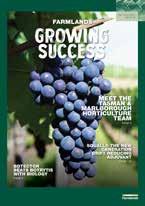
years, Zespri has supported Arxada with investment into alternative budbreakers for Gold 3 Kiwifruit. The additional benefits of; reductions in lateral flowers and a favourable short re-entry interval of ‘when fully dry’, makes Advance Gold an effective and safer alternative to existing budbreak technology in Gold 3 Kiwifruit.
With A.I nozzles and a Drift Reducing Adjuvant mandated by Zespri for applications of hydrogen cyanamide, Squall®, a specific Drift Reducing Adjuvant, is a very effective solution. Squall has been tested infield with hydrogen cyanamide (and other pre-flower sprays, including bactericides) and has proven to be both highly effective, tank mix compatible and crop safe. Squall is also compatible with Advance Gold, although not mandated to be included by Zespri, it can be beneficial to further mitigate drift, enhance deposition and improve rainfastness.
Contact your local Farmlands Technical Adviser or Horticultural Sales Representative for more information on how Advance Gold® and Squall® can benefit your growing operation.
farmlands.co.nz | Farmlander | 51 AUTUMN CHECKLIST | Horticulture
AUTUMN CHECKLIST
PRUNING GRAPEVINES
The way forward with Simonit&Sirch
Mart Verstappen, Farmlands Technical Leader Viticulture, shares his thoughts on the important task of pruning grapevines and how Farmlands’ relationship with Simonit&Sirch can help.
WORDS BY MART VERSTAPPEN
Pruning is one of the most major and important tasks during the growing cycle of a grapevine and is performed on an annual basis. This determines not only the potential yield and quality of the harvest but also has an impact on other processes during the season like vigour, ripening and more often the neglected health and longevity of the plant.
It has been discovered that a number of wood pathogens related to trunk disease have been able to get established in New Zealand due to very general pruning rules being
applied to this important task and inadequate knowledge of the correct techniques to use.
Simonit&Sirch is an Italian training and consulting company with the objective to improve vine health and longevity through effective pruning techniques. Their extensive research in pruning grapevines spans a 30 year period and has now been adopted by some of the most prestigious wine producers in the world.
Farmlands is proud to have worked with Simonit&Sirch since 2019, as it recognises the importance of extending
their knowledge, skills and services to the New Zealand wine industry.
Adapting a new pruning style will require a mind shift from growers. The method’s basic principles work around understanding how a vine grows and to identify the importance of sap flow continuity and what effect pruning cuts have.
A series of informative workshops and demonstrations have been conducted in New Zealand’s main viticultural regions with great attendance from grape growers resulting in a number of growers
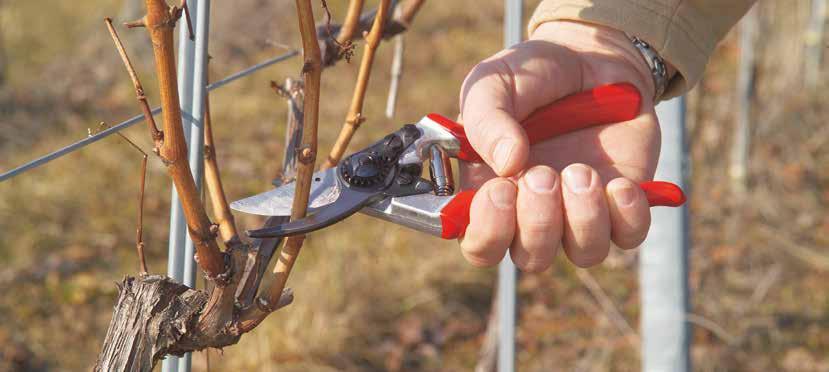
52 | Farmlander | farmlands.co.nz
adopting these techniques through one-on-one training and continuous support during the growing season.
Simonit&Sirch and Felco are two key companies in the wine sector, internationally renowned and presenting worldwide on topics such as vine training, tutoring, quality in the performance of pruning and the most suitable tools for safety and ergonomic comfort of the operator.
For years Farmlands has been able to supply pruning equipment from Felco, a Swiss company that,

with their quality and ergonomics, understands two equally important things: The wellbeing of the pruners and the wellbeing of the plants on which we work.

Farmlands is looking forward to continuing and strengthening this relationship with Felco and Simonit&Sirch by bringing continued support to the New Zealand grape growing industry and promoting the improved Simonit&Sirch techniques, leading towards improved vineyard sustainability and economic longevity.
PRUNE LIKE THE EXPERTS
Recent decades have seen a revolution in vine pruning, and now arguably the most influential book on the subject is available in English. First published in Italian in 2014, Guyot Methodology: The Vine Pruning Manual to Limit Trunk Diseases is a ground-breaking handbook, offering the reader step-bystep instructions to Simonit's renowned approach to pruning, from vine establishment to maturity. Get your copy now from Farmlands Online Shop.

These pruning shears/secateurs have an ingenious design which makes them ideal for your heavy-duty cutting tasks. The superior ergonomics are especially suitable for anyone with larger hands filling you with a confidence that begins with the robust foundation of the tool’s firm and comfortable grip. With an angled cutting head design the Felco 8 immediately becomes a natural extension of your hand, making you more efficient as you move from one pruning job to the next.
FEATURED PRODUCT Felco 8 Secateur Ergo Angled Head 210mm LG

This high performance and ergonomic one-hand pruning shear is ideal for grapevine pruning as pictured in this series of images. Get your pair from your nearest Farmlands store or shop online at shop.farmlands.co.nz

farmlands.co.nz | Farmlander | 53
PHOTOS: SUPPLIED BY SIMONIT&SIRCH
AUTUMN CHECKLIST | Pruning
Nil withholding, for when she needs it
To bring out her best, CYDECTIN® Pour–On provides flexibility when drenching. With nil withholding periods for milk, meat and bobby calves, you can treat your cows if and when they need it.

CYDECTIN Pour–On is long lasting, with 35 days protection against Ostertagia ostertagi. It kills biting and sucking lice too. So keep your profits up and parasites down. Invest in CYDECTIN Pour–On



— New Zealand made for healthy Kiwi cows.
Available from Farmlands stores nationwide.
Zoetis New Zealand Limited. Tel: 0800 963 847; www.zoetis.co.nz. CYDECTIN is a registered trade mark of Zoetis. ACVM No. A6203. ™ For more information visit cydectin.co.nz
BUY

With deferred payment on Seed and Agchem through Farmlands.*

Put yourself in a better financial position this autumn and get your annual ryegrass and sprayouts underway.
Talk to your Farmlands TFO or visit your local store today.

TIME YOURSELF SOME *Terms and conditions apply. Deferred payment is available on selected Annual Ryegrass products, subject to credit approval, until 31st May 2023. Deferred payment term of 90 days is available on selected Nufarm’s products, subject to credit approval. For further details, please contact Farmlands on 0800 200 600. FAR_10805
AUTUMN CHECKLIST
DAIRY Choosing the right supplement
Ensuring your cows have the right supplement is a crucial part of setting them up for the upcoming season. Luckily Farmlands’ NRM feed specialist Robert ‘Dr Rob’ Derrick is here to offer help and support to make sure your animals are getting the best and most nutritious diet.
 WORDS BY ALICE SCOTT
DR ROB DERRICK HEAD OF PRODUCT DEVELOPMENT
WORDS BY ALICE SCOTT
DR ROB DERRICK HEAD OF PRODUCT DEVELOPMENT
Condition scoring dairy cows around this time of year is a key priority for dairy farmers as herds head into late lactation and drying off is on the horizon, Rob says. With a long background in ruminant nutrition both in New Zealand as well as the UK, Rob completed a degree in Agriculture at Aberystwyth University in Wales and was offered a scholarship

56 | Farmlander | farmlands.co.nz
which allowed him to research the nutritive value of a wide range of grassland species for which he was awarded a PhD.

Rob’s expertise in the matter and subsequent PhD means his colleagues often refer to him as ‘Dr Rob’ “It’s a nickname that seems to have stuck,” he laughs.
“Some of my research was done at the Welsh Plant Breeding Station from which some of the best-known ryegrasses and clovers have originated.”
Arguably ahead of his time, Rob investigated the feeding value of diverse grassland species including plantain. “I focused mainly on dry matter intake but coming from a perspective that just ryegrass and clover pastures may not be the ideal diet for ruminants.” Thirty years later research is showing that species diversity could have benefits for both the grazing animals and the planet in terms of sustainability.
Rob has been working as a ruminant nutritionist for Farmlands for more than 10 years and was instrumental in formulating the supplementary feeds which are created by its subsidiary companies NRM and Reliance Feeds.
“When it comes to dairy cows it might seem counter-intuitive to continue supplementing in mid and late lactation when there is grass to eat but it can be a profitable time to feed cows to support both milk production and weight gain. Increasing days in milk whilst supporting body condition gain is a major advantage of the appropriate supplementation. Choosing the right supplement from the wide range now available is the key.”
Protein levels in autumn pasture can rise and Rob says it may not be
worth paying a premium for higher protein by-products as the protein needs of cows can fall as days in milk increase. “This autumn, some regions will have access to a limited amount of citrus pulp pellets that have been brought across by Viterra. Citrus pulp pellets offer a great source of digestible fibre and sugar but very little protein. So long as people want to drink orange juice, there will be masses of by-product after extraction that are better suited to ruminants than pigs and poultry.”
Keeping the cows in good condition is important heading into late lactation, if milk production goes down, so does feed intake and it can be a downward spiral leading to a longer dry period for the cow. “We are all feeling the financial pinch and thinking about where we can achieve cost savings. It can be tempting to supplement cows with a lower cost feed, but it can come at a long-term expense and creates inefficiencies. Feeding something that is already in excess, even if it is cheap, can be unprofitable; feeding something that is missing from a cow’s diet, even if it is expensive, can be better and more effective in the long run,” he says.
Rob says information from cow collars is highlighting the effects of heat stress on rumination time and dry matter intake. “Cows that we thought were dropping production because of pasture quality or the impact of facial eczema might well be experiencing heat stress. Nutritech has seen good responses to a heat stress additive pack which we offered to farmers for the first time this Summer.
“It is better to target the limitations in the herd’s diet. I would be telling dairy farmers how to suck eggs if I advised them on how to manage their herds in terms of grouping by body condition, when to dry off and whether they drop to once-daymilking during late lactation; but there are definite efficiencies that can be gained when choosing the right feed supplements,” he says.
Knowing the right supplement to buy can be challenging, and Farmlands has experienced Nutrition Specialists who can help farmers decide which supplementary feed is most appropriate for their herd at a particular time. “The cow is the best indicator of the diet quality and our specialists can get a real-time appreciation of how well the diet is supporting the cows by reviewing the production figures and the cows themselves,” he says.
To get in touch with your local Nutrition Specialist call 0800 800 380 or flick an email to customerservices@nrm.co.nz
FEATURED PRODUCT Nutritech Rumensin Trough Treatment 60L

Rumensin® is a well known ingredient for lactating and dry cows that increases milk solid production and improves feed efficiency under many conditions.
$1272.00
Find in-store at Farmlands or purchase online at shop.farmlands.co.nz
farmlands.co.nz | Farmlander | 57 AUTUMN CHECKLIST | Dairy
“It might seem counter-intuitive to continue supplementing in mid and late lactation when there is grass to eat but it can be a profitable time to feed cows to support both milk production and weight gain.”
BASICS DONE WELL see future benefits
Rearing calves can be tricky – but never fear, The Calf Experts are here. Karen Fraser and Stacey Cosnett share their tips on how to make sure your calves have what they need even before they are born to ensure a healthy season.
 WORDS BY KAREN FRASER & STACEY COSNETT
WORDS BY KAREN FRASER & STACEY COSNETT
Autumn is often the preferred season when it comes to rearing calves due to the climate. But to optimise the outcome it’s important to get the basics right.
Calf rearing doesn’t start the minute the calf is born. The last month of pregnancy is a critical time too, as this is when the calf is growing rapidly and colostrum generation starts in the cow’s mammary glands. If the pregnant
cow is on an unbalanced diet that is low in protein, energy or vitamins and minerals, this can affect the calf and her colostrum quality, in turn affecting the calf rearing season somewhere along the way, even in the best season.
Annual vaccination boosters for clostridia, rotavirus and salmonellosis all become equally important. Often the season starts out well for autumn rearers, only to get hit with all the

58 | Farmlander | farmlands.co.nz
CHECKLIST
AUTUMN
nasties later, especially if calves are exposed to relocation stress on day five of life.
So, we know that cow basics need to be met before the calf hits the ground but how are you meeting all the other requirements?
Doing the basics well will pay dividends right through the season. Have you heard about the Calf Expert 5C’s?
1. Colostrum – 5Q’s- Quality, Quantity, Quickly, Quietly, and sQueaky clean. Don’t know what we mean? Check out our colostrum video on The Calf Experts Facebook page.
2. Calories – Are you feeding enough energy? Fortifying milk or mixing the replacer to a higher concentration is an effective way to increase calories without increasing volume. But make sure every calf is receiving enough!
3. Cleanliness – Limit exposure to disease-causing organisms. Bad bacteria multiply fast in warm or wet environments

4. Comfort – Dry and draught-free, with good ventilation but watch for heat stressed calves in those autumn sheds. Often there are not enough shaded areas.
5. Consistency – Calves require consistency in all areas particularly in feeding and handling.
Things to avoid in the first couple of weeks, which affect calf performance.
• Overfeeding/underfeeding –offering too much of a good thing early on, so stick to feeding the right amount for the size of the calf and make sure a slower calf is pulled back and fed better.
• Milk being too hot or wrongly mixing calf milk replacer – This can denature the protein, affect
minerals and vitamins, or influence the calf’s ability to digest.
• Not cleaning equipment daily/bad hygiene practices – A breeding ground for all things bad. The bug burden eventually overwhelms the calves ability to fight off those nasties.
• Shed health failing – When they start to fail it exposes calves to numerous health and growth issues, including respiratory diseases that can affect the calf permanently.
• Taking those “free” or cheap calves – Often rearers are offered all sorts but stick to your guns and only take the best calves. Look at the weather patterns five days earlier, to make sure those calves you’re buying weren’t born during a storm.
• Always treat calves as individuals
– When in a mob monitor each calf while it is drinking so that every calf gets what it needs, it’s not ideal to fill feeders and leave.
• Failing to teach good habits early
– Do you offer too many things in the first week of life? The earlier we teach calves to eat calf feed straight after the milk feed, the better the rumen development will be and they will get less of a weaning check.
• Slow to respond – If that calf didn’t drink or was slow to stand, don’t wait and see. Act fast to reduce the impact. Take temperatures and start electrolyte therapy.
• Bad timing – Vaccines, drenching, dehorning, weaning or transitioning. We can get these timings a bit out of whack and weaken the immune defence.
• Expecting too much from lush autumn grass and then winter pastures – The young ruminant will respond better when we carry on feeding a balanced calf feed in the weeks and months after weaning.
It’s human nature to look for explanations to the things that went wrong, often initially wrongly accusing milk powder or calf feed as the cause. But 99 percent of the time (provided you have purchased quality CMR and hard feed) it all could have been avoided. The perfect storm is often building, without you even realising. Keep programmes simple with good hygiene practises, excellent quality milk powder, well balanced quality hard feed and always have a good quality electrolyte like Reliance Blue Boost on hand as the cornerstone of your system.
Contact your local Farmlands Nutrition Specialist or Farmlands Technical Field Officer to help you with your autumn calf rearing requirements.
Follow the Calf Experts on Facebook for more advice and info on upcoming events.
FEATURED PRODUCT Reliance Blue Boost

Electrolyte 12kg
An innovative new electrolyte developed by Farmlands' inhouse experts.
$248.00
Find in-store at Farmlands or online at shop.farmlands.co.nz
farmlands.co.nz | Farmlander | 59 AUTUMN CHECKLIST | The Calf Experts
Often the season starts out well for autumn rearers, only to get hit with all the nasties later, especially if calves are exposed to relocation stress on day five of life.
TOP TIPS FOR THE DAIRY SHED

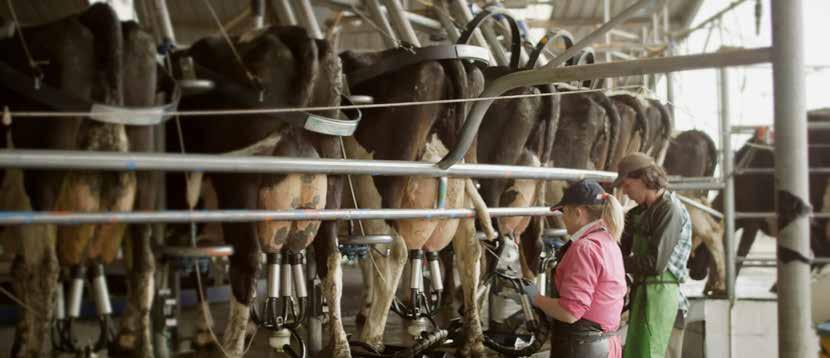
To get the most from your dairy shed this season, it pays to correctly set up your shed and perform regular maintenance checks to maximise the efficiency of your milking system. This helps to minimise the likelihood of teat end damage and the risk of grades.
Heading into autumn, follow these tips to troubleshoot common issues. You can also watch Skellerup’s top tips for the dairy shed.
Liners slipping off claws
Check liner tailpiece is the right size for your claw. If liners are slipping off the claws, it could be that the liner tailpiece is too large.
Damaged liner tailpieces
SPLITS: Splitting occurs when the liner tailpiece is too small for the claw and when liners are not pushed fully onto the claw.
HOLES: Check claws for sharp edges and burring, as this can exacerbate any impact damage to the liner tailpiece.


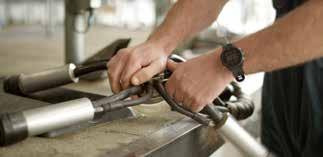
2,500 liner change

The industry standard from DairyNZ is to change liners after 2,500 milkings. Liner shape, tension and inner surface condition deteriorate over time affecting their milking performance.
• Flex cracking in the barrel. Increased risk of liners splitting. Bacterial growth in flex cracks can contaminate milk and impact your grade.

• Mineral deposit build-up. Mineral deposits lead to an abrasive liner surface, damaging teats and increasing the risk of infection.
• Liner mouthpiece and barrel distortion. The result of swelling from milkfat and chemical absorption. Liner mounting tension is critical for pulsation and maintaining a high flow rate from the teat while stimulating milk flow. Incomplete milk-out can contribute to higher somatic cell counts (SCC) and an increased risk of mastitis. Wornout liners lead to lost performance due to cup slip and increased average milking time.
For expert advice and recommendations on your rubberware requirements this season, contact us for a free consultation of your dairy shed. Book a farm visit today with your local Skellerup Technical Specialist at www.skellerup.co.nz/ book-a-farm-visit
In association with Skellerup
Use the liner change calculator Scan here to find out when your liners need changing and to set a calendar reminder. 60 | Farmlander | farmlands.co.nz



Drive your profits with quality, custom-blends from Farmlands. Purchase feed through Farmlands this autumn and our experts will craft a custom blend for your stock.* Talk to your Farmlands TFO or a Nutrition Specialist today. Find your specialist at farmlands.co.nz/NutritionSpecialists Wealth health is your Their *Terms and conditions apply. FAR_10805
What you need, when you need it
Farmlands Chief Merchandising Officer, Chris Fisher, on transforming supply chain management within the co-operative.
Chris Fisher joined Farmlands/ Te Whenua Tāroa in 2021 and is now responsible for relationships with over 1,100 product suppliers, sold through Farmlands’ national network of stores and directly to customers on farms and orchards.
Chris is also making sure we hold true to our foundations, to get the best price for our shareholders, through combined volume. He explains...
Why does Farmlands need to change the way it supplies products to customers?
We need to provide our customers with a consistent range of products at the best possible price across our whole network. We must look at our offer, where it is needed and when in the year.
Understanding our customers is fundamental to knowing what to buy. We can then pick a range of products that fit their needs. The choices the buying team make I describe as being a blend of art and science. The science being the data and past trends, while the art is the interaction with suppliers and shareholders on where they think the requirement is.
Creating a consistent core range like this will better support both our customers and the suppliers we partner with, now and into the future.
What benefits will customers and shareholders notice?
They’ll notice a reliable mix of products and some local flexibility and this’ll result in better prices and efficiency over time. Having a core range of products means we can clearly communicate our offer to the market. We can have more structured conversations with our suppliers and operationally we can be more efficient in lowering our cost to serve and improve availability.
It also makes shopping a bit easier for customers and staff – it’ll be simpler to make a choice with less distractions and unsold stock won’t end up sitting around. All of these things will help us offer lower prices and do a better job of helping drive profitability on-farm.
What is the best insight you've picked up from talking directly to Farmlands customers?
I've been amazed by how strong the industry’s been while dealing with all of the uncertainty around the environment and the economy. At the moment, the big thing for many shareholders is cost – everyone is under huge pressure to cut costs. So what I’m hearing is, Farmlands needs to provide a bit of certainty, be more reliable about providing the right
specialists in the right place, along with the right products so we can understand and meet the needs of shareholders and their businesses.
Having come from another industry, I’m amazed by how the faming sector is able to deal with what I would consider to be the uncertainty within the value chain. Many of the shareholders I have met are the buying team, HR team, operations team, logistics, finance team all rolled into one and I am genuinely honoured to have this opportunity to support rural NZ.
When and where will we start to see the plan rolled out?
We’re already rolling out our core and local ranges in Ashburton, Invercargill, Darfield, Richmond, Marton, Matamata, Opunake and Helensville stores. The ranges will be available in all of these stores by the middle of March 2023. Invercargill was one of our first stores to be up and running with the new offering, so the whole store is now chockablock with the key products that Southern customers rely on and we’ve already received positive feedback about the changes. At the same time this is a new approach and nothing is perfect. We will learn and improve along the way.
What else is going on to improve customer experience?
We have our new ‘All-In Deals’ going live in March. The aim of this is to enable shareholders to come together to commit to volumes as a whole, rather than as individuals. The key benefits here are that whether you own 2,000 hectares or 2, you will benefit from the scale of the co-op you all own. As we learn from the first promotion, we will continue to scale the offers we bring to market.
There is a lot going on. We are investing in the right changes and in the immortal words of Mark Twain “Steady progression is better than delayed perfection.”
62 | Farmlander | farmlands.co.nz
Get in touch with Chris at Chris.Fisher@farmlands.co.nz
PHOTO: RICHARD BRIMER


farmlands.co.nz | Farmlander | 63 AUTUMN CHECKLIST | Supply chains
Lay of the land


64 | Farmlander | farmlands.co.nz
In this section
Expert advice on topics across farming disciplines to help you have a successful season, whatever your field.

66 Fifth generation farmer Alan Curnow reflects on how the power of community helped him and his wife Sandy get through some dark days after a massive flood left them stranded.
90 The Brother’s Green are working hard to change public perception of hemp and marketing this misunderstood plant to a global market.
94 From discounted farm inputs, power, fuel, and even savings on the weekly grocery shop, there are thousands of ways to use the Farmlands Card.
96 Partner and specialist property lawyer Annabel Sheppard shares her expert advice on rural property management.
farmlands.co.nz | Farmlander | 65
Photo: Bailee Reuben
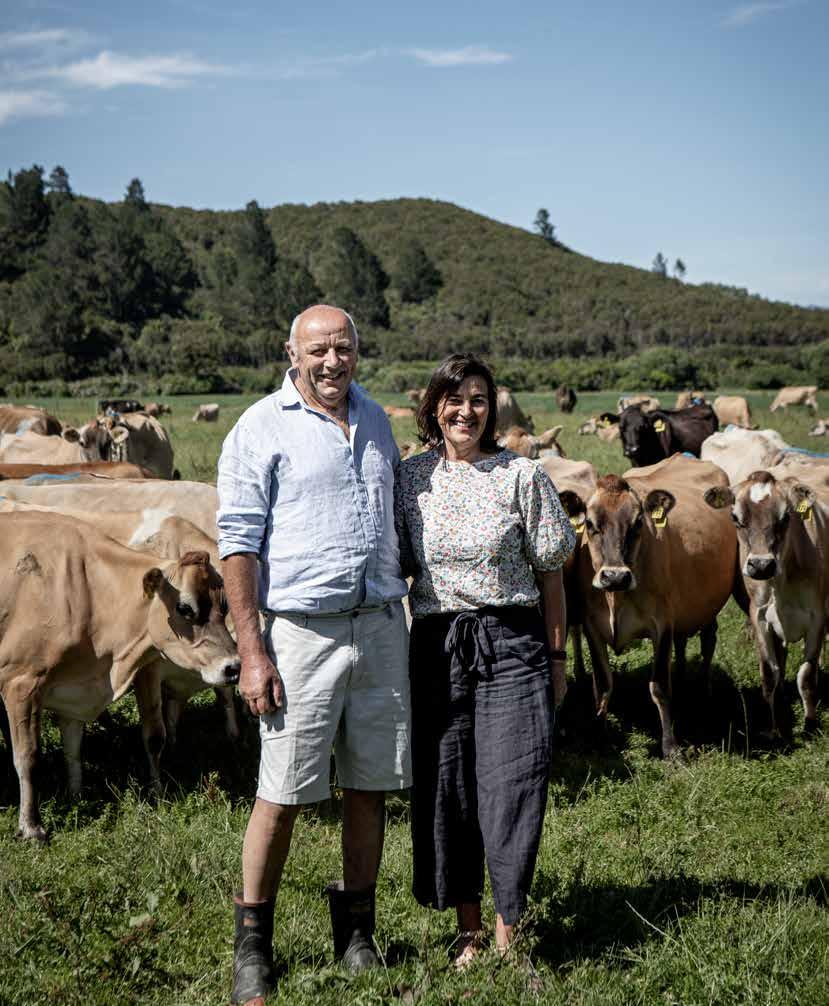
66 | Farmlander | farmlands.co.nz
Alan and Sandy Curnow on their family farm.
SILVER LINING
WORDS BY AYLA MILLER BAILEE REUBEN
Tucked under the Wakamarama range, below the curve of Farewell Spit and between Collingwood and Bainham, lies the Curnow family dairy farm. Running to the West Coast weather forecast, the farm experiences more than its fair share of rain, resulting in some extreme weather events in recent years.
But the rain can’t dampen the spirit that exists in this small farming community.
Although the area has always had high rainfall, Alan says the weather has become more extreme in the past few years with more flooding and droughts.
“We get a number of showers through the summer, so we don’t irrigate but the real challenging thing is when we get a drought before Christmas when we haven’t made supplement.”
Having grown up on the farm, Alan has seen first-hand, the challenges that come with farming in this area.
His introduction to farming was somewhat of a trial by fire when his father suddenly passed away. At the time, Alan was three months off completing his building apprenticeship. Wanting to help his mother Marion, he offered to return to the farm to help her. She refused his offer and encouraged him to finish his studies while she continued to run the farm alongside Alan’s uncle, Noel.
As soon as Alan completed his studies he moved back to the property and when his uncle’s health deteriorated,

took over his share. Not long after, his mother also decided to hang up her farming boots. By this time Alan had married Sandy and they were able to buy the farm together in 1982.
The pair went on to raise their three sons on the farm. All followed in their father’s footsteps with two becoming builders and one staying in farming. In 2004 Alan and Sandy split the farm next door with a neighbour and the Curnow farm grew to become 249 hectares with 420 cows, supplying milk to the Fonterra Takaka Milk Plant.
One of the most difficult times for the Curnow’s was in February 2018 when Cyclone Gita hit, damaging the Kaituna River bridge in Collingwood and severing the link between the farms in the area and the tanker collecting their milk.
“Gita was the one that really did a lot of damage to us because it caused a lot of slips in the Kahurangi National Park. It dammed the bridge at the top of our road and sent the river right across our farm. The other main access road dropped a metre and a half in the middle, so they closed the road and the tanker access as well.”
“It was a bit of a panic for a while,” says Alan.
Unfortunately, there was no solution in sight when it first happened, and the cut-off farmers had no other choice but to dump 10,000 litres of milk.
Up to $1 million worth of milk was at risk of being lost if it wasn’t for the helpful neighbours and local
farmlands.co.nz | Farmlander | 67
Fifth generation dairy farmer Alan Curnow, and his wife Sandy, know only too well the havoc Mother Nature can play on those who work the land. Here, they reflect on how their small community rallied to help get them through some of the darker days.
LAY OF THE LAND | Curnow Farms
contractors who banded together and organised one of the neighbouring farmers stock bridges to become a make-shift tanker access point.
“At the time of the floods, it was really lovely because the neighbours all came together,” says Sandy.
“I will never ever forget that. Tom, our eldest son was farming as a manager near Nelson at the time and his helicopter pilot friend flew in and landed on our front lawn to help with the clean-up.”
Farmlands Motueka was also helpful in delivering important supplies as the farmers waited for the slips to be cleared Alan says.
“They would bring supplies in like posts and all that sort of thing that we had trouble getting, which was critical after the flood. We were raiding the neighbours for whatever they had in the yard because we couldn’t get stuff in until Fonterra operated a barge to come around.”
Although natural disasters like floods are unpredictable by nature, Farmlands Motueka Business Manager Lexi Brady says the best things farmers can do to prepare and minimise damage caused by these events, is to check waterways are clear and liaise with the council if they need clearing.
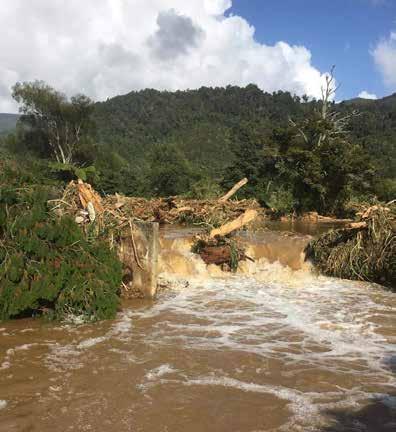

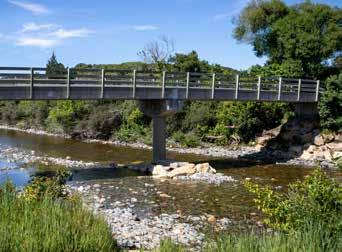
“Make sure the farm is clear of any potential debris like fallen trees, bale wrap/net etc. Placing bales on higher ground can prevent them from getting washed away.”
It’s also important to make sure insurance policies are accurate and up to date regarding loss of fencing through flooding she adds.
“We’re always here for a chat, whether you need advice on what drench to be using this time of year, or someone to brag to about your kid’s rugby game in the weekend. We’ll be here in store, or on the phone whenever you need.”
Nowadays Alan tends to carry more supplement just in case “because these events are happening out of season and out of sequence so you’re not safe anymore. You’ve basically got to form your own security,” he says.
The silver lining to the whole ordeal was the community spirit that got them through, the pair say.
“It was generous of all these people to give their time up for us which we will never forget. Because there were so many of us, we would go up to another local up the road and she would do all the meals for us at night,” Sandy says. “It was really fun because at the end of the day we’d all meet up there and she would cook for us all. I didn’t want that to end.”
Although when flooding and other natural disasters strike it can be extremely stressful, Alan says having a good community to rally around makes it easier.
“Two days after the big flood about 10 neighbours turned up with fence posts, wire and two post drivers and they formed gangs and went around stripping fences and replacing wires,” he says.
“I think it’s amazing how much support there is in small communities.”
68 | Farmlander | farmlands.co.nz
Photos from around the farm and the community show the extent of the flooding to the region.
WE’RE NOT ONLY HELPING TO GROW FOOD, WE’RE ALSO GROWING SUCCESS.
Get stuck-in to the latest edition of New Zealand’s MUST-READ publication for growers. From new products and technology, to best-practise and developing trends, Farmlands partners with the best in the industry to keep you up to date with what’s happening in New Zealand horticulture.

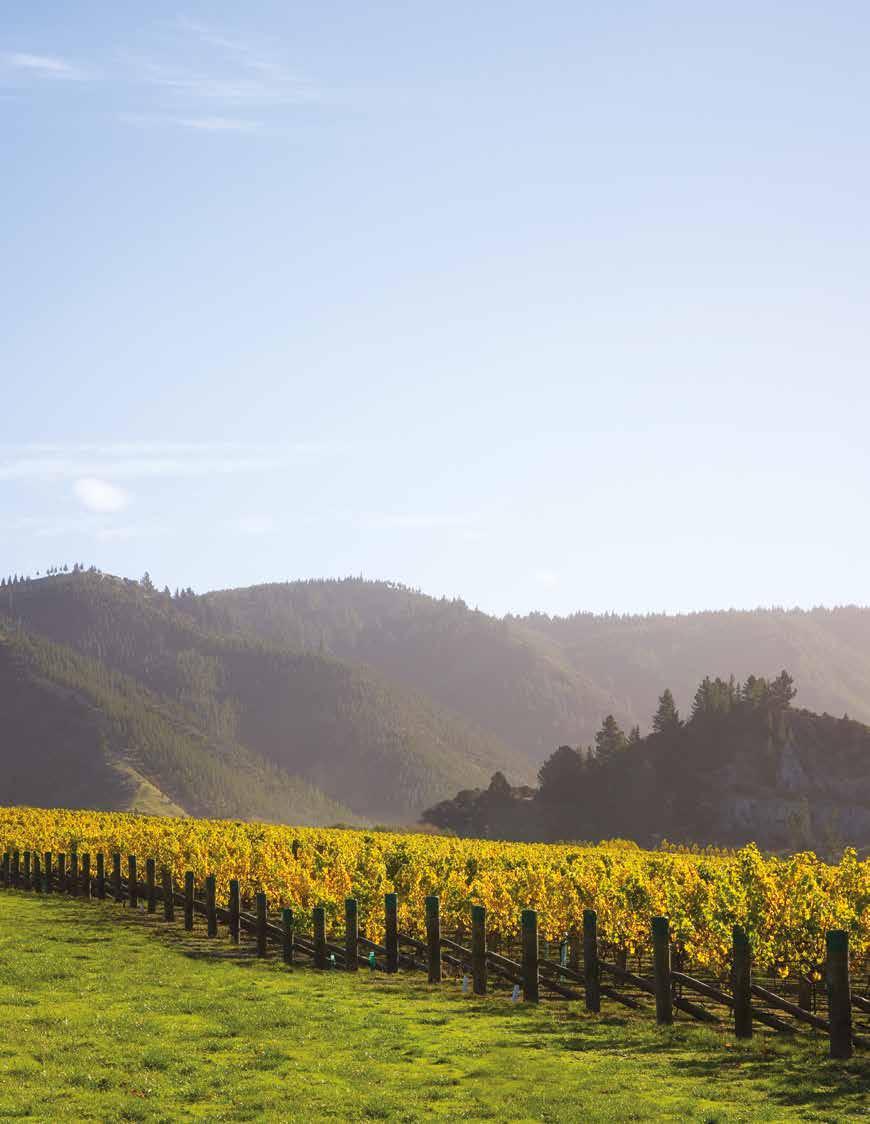
OUT NOW
Read Growing Success now by scanning the QR code

70 | Farmlander | farmlands.co.nz
PHOTO: SUPPLIED BY NZKGI
In early October last year, the Bay of Plenty area was hit by a severe frost – the first of its type to hit the region in over 10 years. The event proved catastrophic for many kiwifruit growers who were already coming out of a particularly difficult few years. Farmers and those working in the industry explain how the recovery effort is tracking and how Farmlands is offering support.
WORDS BY SASHA WATSON
On October 6th, 2022 a large area of cold air moved over the whole of New Zealand causing damage to crops in the South Island, Waikato and Auckland areas as well as resulting in an advective frost event which hit the Bay of Plenty area hard.
Growers likened this frost to events last seen in the late 90s. And while they were prepared, an advection frost of such magnitude was unexpected.

Coming out of a run of several tough years, both financially and production wise, many growers in the Bay of Plenty were devastated to lose between 5-25 percent of their crop.
Katikati bore the brunt of the damage with many orchards in need of recovery and recuperation. Blocks which lost all their buds will have no crop this year but still face a year ahead of maintenance costs and unknown effects on the cane growth for future crops. This placed many growers and orchards under stress, particularly with the forecast of payouts being down on the 2022 crop and now having a reduced crop, or no crop at all coming into the 2023 season.
Both Mark Mayston, a kiwifruit grower and spokesperson for New Zealand Kiwifruit Growers Incorporated and Alistair Grant, Orchard Operations Manager at Hume Pack-N-Cool,

LAY OF THE LAND | Kiwifruit growers farmlands.co.nz | Farmlander | 71
are in the midst of managing the recovery of their growers’ orchards, and are focusing on keeping their damaged canopies open and healthy for the next season.

Mark highlights that “the entire year’s growth will be affected by the recent frost,” and it is important to start the 2023/24 season with clean canopies.
“Putting effort into recovery and maintenance is prudent for future growth,” says Mark who is in the process of cutting vines back to allow new canes to pop through.

Alistair says that while growers who had frost fans, sufficient water and overhead irrigation fared slightly better, the region was unprepared for significant frost and hopes this is a “one off event”. He is also in the process of opening and maintaining his growers’ blocks to allow maximum light access for next season's canes.
The unusual weather has continued since October 2022 with a particularly wet summer for the Bay of Plenty. While not ideal for fruit growth, the rain has been positive for blocks in a recovery mode, Alistair says.

DID YOU KNOW?
The wet season has retained moisture in the earth, providing natural irrigation and ideal vine growth conditions, a small benefit for stressed blocks and growers.
While expansion of growing areas over the last decade may have created a higher frost risk in some areas, the advective frost puts every orchard in a degree of danger, while rendering traditional frost control measures less effective due to the absence of an inversion layer of warmer air above the orchard. Frost fans and helicopters would normally gain some heating action of the orchard environment by mixing the warmer air with the cold or even displacing it. But in the advective frost situation, this does not occur, as the inversion layer was too high to reach.
Like Mark and Alistair, Farmlands staff have been working hard throughout orchards in the region to provide as much support as possible. Mark says that being surrounded by a close-knit growing community and having Farmlands as a source of technical advice and emotional support is helping. Farmlands has held field days on frost recovery and catered to many growers in the region, holding barbecues and continues to be a great source of information.
“Especially with the recovery from the frost, Farmlands has been visiting orchards and providing much needed support and help,” Mark says.
72 | Farmlander | farmlands.co.nz
According to National Geographic, advection frost is a collection of small ice spikes formed when a cold wind blows over the branches of trees, poles, and other surfaces.
Mark Mayston, New Zealand Kiwifruit Growers Incorporated (left) and Alistair Grant, Orchard Operations Manager at Hume PackN-Cool (right) are focusing on giving their growers the best start for the next season.
PHOTO: BRENNAN THOMAS, STRIKE PHOTOGRAPHY
Jeff Dunstan and Dwayne Farrington, who are part of the co-operative’s Bay of Plenty team, say that Farmlands is there to help every grower with anything they need for this year’s recovery and next year’s growth.
Having the technical advice needed to continue growing after the less than ideal start to the season, Farmlands will continue to provide what the growers need and as a great point of call, growers who haven’t seen such damage, are encouraged to be resilient.
“Have a breather, take a few days to settle and let's work from there. Let's build and grow new canes,” Jeff adds.

There is a vast variety of products to get through this season, to which Farmlands is more than happy to recommend.
A positive to the season was having a chance to reflect, a good business practice for positive farming. Looking back, Jeff says the industry showed its true self and the network coming together to support and help each other to work through the devastation was “a beautiful thing”.
Further north, where kiwifruit blocks did not experience frost damage, growers have also experienced a challenging start to the new season but for different reasons.

Coming out of a very wet winter, poor winter chilling has resulted in a variable bud burst for the kiwifruit growers in Whangārei and Kerikeri. The mixed start can result in lower crop numbers and variability of quality so growers have been working hard over the spring months to maximise their 2023 crops.
West of Whangārei, in the village of Maungatapere, Craig Watson is a second generation grower on a mixed
12 hectare orchard of avocados, bananas, kiwifruit and tamarillos. Following a good 2022 harvest, Craig says that it’s a disappointing start to the season but he remains optimistic and understands these challenges are a big part of life, especially in the horticulture scene.
“Working with the lower flower numbers we have this year, we have paid particular attention to our pre-flowering nutrition this year to optimise the crop.”
Craig has been using Biolchim foliar products distributed by Farmlands during this particular period of growth. He especially likes the effect of Folicist, to align the growth and condense the flowering period.
“For the last two seasons, Folicist has brought the flowering together nicely into a compact five to seven day period,” he says.
Farmlands Technical Advisor for Northland Philip Elliot adds that there are many products in the Biolchim range that can add benefit when a vine has had a stressful start to the growing season.
“Biostimulants such as Fylloton can also be particularly beneficial in reducing plant stress early in the growing season, and getting the vine back up to full growth after a stress event.”
Fylloton can also work well when added to Folicist to enhance the plant's metabolic processes as it moves into the pre-pollination window (another stress event). Fruit growth since then now sees a crop of good size and consistency, with the aim now to finish a crop of 12,000 trays per hectare with good taste characteristics.
farmlands.co.nz | Farmlander | 73
LAY OF THE LAND | Kiwifruit growers
PHOTO: SUPPLIED BY NZKGI
FEATURED BIOLCHIM PRODUCTS
FOLICIST®
Metabolic enhancer of flowering and fruit set.
• Optimises and uniforms flowering
• Facilitates pollen germination and fruit setting

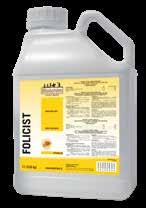
• Supports plant metabolism during the reproductive stage
FYLLOTON
Improver of plant growth based on vegetal amino acids and seaweeds.
• Promotes plant vegetative growth
• Improves plant recovery from stress
For more information contact a Farmlands Technical Advisor or your local store.
Since flowering, the team have been concentrating on managing canopy growth, which can dominate when fruit numbers are lower. Regular spring rain has resulted in a rainfall of just over 2200mm for the 2022 calendar year.

Craig is hopeful for an improvement in the weather, as dry and sunny conditions are helpful in finishing the crop to a high taste standard.
“While a wet spring is challenging, a wet end to summer is worse for us, so we are very hopeful that the weather dries up soon,” he adds.
A bonus of the season has been that very little flower or fruit thinning has been needed, to date, which enables more time to be spent in the development of a Zespri Red19 block.
Grafted in August 2022 onto five year old rootstock, the block is growing well, with an aim to produce a first crop in 2025. This new cultivar has a bud burst date roughly a month earlier than gold kiwifruit varieties, so brings its own challenges with higher exposure to frost risk and variable weather in early spring.
Craig says it is going to be very important to get the red vines growing quickly in spring so has chosen a warm site with existing shelter and an overhead crop canopy is now in place.
“Every season growing brings a new set of challenges,'' says Craig. “With a variety of cultivars and crops, we aim to keep learning and evolving to face the challenges ahead and to keep enjoying what we do.”
74 | Farmlander | farmlands.co.nz
Craig Watson and Farmlands Technical Advisor for Northland Philip Elliot.
PHOTO: SASHA WATSON
To celebrate 50 years of Honda on-farm, we’re giving you the chance to win your choice of some great Honda product. Head to hondamotorbikes.co.nz to get yourself into the draw.
CELEBRATING 50 YEARS ON-FARM
The Honda brand is synonymous with rural New Zealand. In fact, this year marks 50 Years of Honda product on Kiwi farms and without question there’ll be many farmers who have a story to tell about their experience with Honda farm bikes.
Another thing worth celebrating, is that your local Honda Motorbikes dealer is now also your local Honda Outdoors dealer. With a full range of proven Honda power equipment to make life on the farm easier. Power equipment that has Honda DNA, meaning it’s built to last and to work in New Zealand farming conditions.

There is a full range of product, including the venerable range of generators for your back-up and remote power requirements. The range has portable generators suitable for running power tools and workshop equipment, which can be used as back-up power for refrigerators and milking equipment.
The lawn care range consists of heavy-duty commercial grade mowers, with a range of self-propelled options for finishing larger rural lawns.
Ride on mowers with features such as a full colour LCD display, a Speed Hold System and USB charging ports. With Honda’s smooth foot operated Hydrostatic transmission and powered by Honda’s range of powerful 4-Stroke V-twin motors, these mowers offer great fuel consumption, low vibration and a long operational life span.
Line trimmers and brush cutters are also part of the range. Equipped with Hondas proven 4-stroke engine, these powerful and responsive products will work anywhere on farm. For those that prefer battery power, your local Honda Outdoors dealer also has a selection of products available. Mowers, trimmers and blowers – all powered by the same universal battery pack.
If you need to get fencing done, the Honda PHB50 borer, provides the
power and torque required by lifestyle block owners and farmers. At only 10.9kgs, it's easily transported to all areas of the farm. It also fits a range of augers and extensions to meet your individual requirements.
Honda also offers a comprehensive range of water pumps including the ever-popular WB20, with capacity to deliver 600 litres per minute. Like so many other Honda products, the WB20 starts first time, every time with Honda’s famous one-pull easy-start system.
Trash pumps complete the range with heavy duty impellers for clearing storm drains or clearing out underpasses where water is mixed with debris.
All available under one roof at Honda Outdoors. Reliable product, qualified technicians and genuine quality parts. Everything you need to keep your farm running.
farmlands.co.nz | Farmlander | 75 In association with Honda hondamotorbikes.co.nz hondaoutdoors.co.nz
As part of its work to support rural leadership, Farmlands is a partner of the Kellogg Rural Leadership Programme and Nuffield New Zealand Farming Scholarships, giving those working in the rural sector valuable professional development opportunities. We speak to two graduates of these programmes to hear about their experiences.
Luke Fisher, Upper South Regional Manager - Retail, for Farmlands, took part in the Kellogg Rural Leadership Programme in January 2022 and says it helped him grow in ways that benefit not only his professional life, but personal as well.

You've been at Farmlands for quite some time, what do you get up to at the co-op?
I have been with Farmlands fourand-a-half years, I started as the Business Manager of the Motueka store after moving to the South Island from Auckland after getting married. After two years in branch I moved into the Provincial Manager role overseeing the Tasman region of Motueka, Richmond, Blenheim and Kaikoura. During this time I also covered the vacant Sales Manager role for nine months. At the start of my Kellogg programme in January 2022 I also picked up the three West Coast branches. In October of last year I then picked up the three North Canterbury stores to increase the Region to 10 stores from its original
four. I also covered the again vacant Sales Manager role for five more months. I currently oversee the 10 stores north of the Waimakariri River in the role of Regional Manager Retail.
As a recent graduate of the Kellogg programme, can you share details on your experience.
I undertook the first Kellogg course of 2022 which ran from January to July. It was a fantastic experience and by far one of the best professional experiences of my career to date. At Kellogg we are submerged into a course that is focused on our own personal leadership development, this is through coaching and educational sessions alongside sessions with many key influential people from across our industry, we had CEO’s, directors, board members and fellow Kellogg graduates who had gone on to achieve great things. Throughout the seven month course we are tasked with creating a research project which we present on in our final face to face phase. My research project was ‘How to Utilise
a Technical Sales Team to Grow Market Share’. I picked this topic as I could see the potential for Farmlands who had given me this incredible opportunity but it was also an area I felt my knowledge could be improved and immersing myself into this project really helped me achieve that.
76 | Farmlander | farmlands.co.nz
Luke Fisher.
What did you get out of the programme, can you share your highlights?
I applied for this programme to progress my personal capability and to give back to an employer who has given me a huge amount of opportunity for personal growth. Personally I knew my key weakness was my inability to stand in front of a crowd and present and talking to other Kellogg alumni, I knew this was a key part of the programme. We had an incredible day on presenting technique with the late David Nottage which was fantastic and to stand up in the final phase and present my research project was an incredible feeling. I feel I grew an incredible amount through the Kellogg experience.
How has it benefited your career?
I have always been quite self-critical and very aware of my weaknesses. I think Kellogg taught me to actually embrace weakness and use this proactively. I was able to develop a lot as a person which I feel has hopefully benefitted Farmlands in my role, I moved from four stores at the start of my Kellogg experience to 10 stores shortly after completion and have managed up to 21 direct reports during this time. Farmlands has given me some incredible opportunities and I hope my progression and personal growth is testament to the effort and trust my leaders have given me.
Why would you recommend others apply to the programme?
I think good leaders often doubt themselves or put up roadblocks that can limit them. Sometimes it is necessary to close your eyes, walk off the cliff and take the plunge. It is hard to put into words the Kellogg experience as it is so all encompassing when it comes to leadership development, networking and personal growth. It was a truly great experience that challenged me in all the right ways and pushed me to drive myself forward and I could not recommend this enough.
Shannon Harnett, owner and Managing Director of Rural Accountants in Whakatane was awarded the Nuffield Scholarship for 2020. Despite facing Covid related challenges, Harnett says the experience was hugely beneficial and resulted in her being a better team member, leader and coach.
Tell me about Rural Accountants and your work within the sector.


I’m an owner and Managing Director of Rural Accountants in Whakatane. We provide accounting and strategic services for clients predominately but not exclusively in the rural sector. I'm a Chartered Accountant and a Chartered Member of the Institute of Directors and hold a post graduate diploma in agri-commerce. I'm involved in multiple kiwifruit, Rockit apple, sheep and beef and dairy farming syndicates at Board level.
What was a key highlight of the programme or a key takeaway?
My Nuffield experience has been disrupted by Covid travel restrictions. On the bright side, it has enabled me and my 2020 cohort to travel around New Zealand looking at primary sector businesses and other large New Zealand organisations. I have gained a far better understanding of the New Zealand primary sector than I otherwise would have had, had the international travel been available in 2020. However, I have not entirely missed out on overseas Nuffield travel and I’m very excited to be heading to Argentina, France, Poland and Ireland later this year.
What in particular are you passionate about in the sector your work?
Nuffield also focuses heavily on personal development. I think my workmates would agree that I am a better team member, leader and coach for doing the programme. I am certainly now more strategic in my thinking.
How did the programme help you grow this passion?
My Nuffield report, titled Getting Plant Varieties Right, focused on the commercial benefits of plant variety rights and other considerations that need to be met to make for a successful “NZ Inc” now and in to the future. I became very interested in plant varieties when I got the opportunity to be part of Rockit Apple. I was the Group Financial Controller and 2IC for the company until I moved to Whakatane in 2017.
How has it benefitted your career?
By doing the Nuffield programme and writing my report on PVRs I gained a wider understanding of the benefits that the PVR system brings to the horticulture industry; also, an appreciation that the rules of the game are changing, driven by legislative and market forces bringing more focus to social and environmental factors.
Why would you recommend others apply to the programme?
I have really learnt a lot during the Nuffield programme, and I would encourage anyone who is thinking about applying to just do it. My advice to future Nuffield scholars is get a good system for capturing notes and make time to reflect on them. There is a lot of information that comes at you and most of it is gold.
farmlands.co.nz | Farmlander | 77
LAY OF THE LAND | Rural leaders
Shannon Harnett.
AUTUMNOUR TOP PICKS FOR










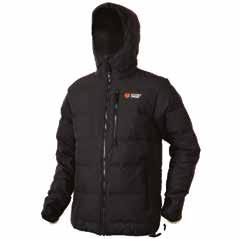






1024353
1042669
1054777 |
1024650
1042758
1025704 |
1034915 | 8.
1024811
Active Tights $89.99 1053979 | 10.
2.0 $199.95 1025144 | 11.
1024227
1024844 | 13.
1024232 | 14.
1024374 |
1024505 Product range varies by store. While stocks last. Scan QR code to shop online FAR_10793 1 2 14 15 4 10 5 6 7 8 9 13 3 12 11
1. Betacraft ISO940 Parka Mens $379.95
|
2. Stoney Creek Tempest Jacket $399.99
|
3. Backroad NZ Windbreaker 2.0 $159.95
4. MKM Tasman Half Zip Pullover $184.95
| 5. Stoney Creek Thermotough Jacket $429.99
&
1042759
| 6. Swanndri Seattle Hoody $329.99
7. Swanndri Women’s Taranaki Tailor Shirt $129.98
Legend Short
Sleeve
Neat Check Shirt Mens $54.95
| 9. Stoney Creek
John Bull Raptor
Skellerup Red Bands $89.99
|
12. Grisport Contractor Safety Boots $265.65
Skellerup Power 4x4 Gumboots $134.99
Backroad Gumboot Socks 3 Pack $44.95
15. Backroad Alpine Boot Socks 3 Pack $44.95

BRIDGESTONE VX-TRACTOR TYRES GAINING TRACTION WITH KIWI CONTRACTORS
Three years ago Bridgestone launched a new range of ultra-highperformance tractor tyres to the New Zealand market. The VX-Tractor series would offer phenomenal traction in all conditions, the ability to handle heavy loads and a long working life, especially when running on roads.
This meant they would be ideal for rural contractors, doing big machine hours and travelling between jobs. Kiwi contractors have now had the opportunity to run VX-Tractor tyres for several seasons and the feedback they’re providing is very positive.
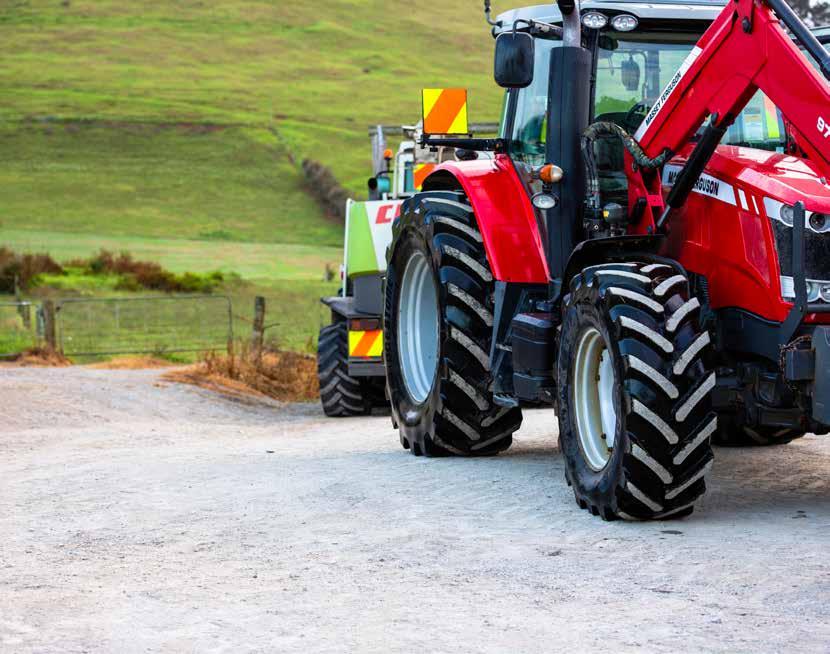
Experienced contractors say VX tyres deliver efficiencies to their businesses, a better ride for tractor drivers and good value for money.
Bridgestone Specialty Products Manager Nathan Darke says: “VX-Tractor tyres have a patented lug design, the ability
to handle a range of tyre pressures and a six-layer tread belt. They’re made from a new rubber compound that’s even more resistant to wear than previous Bridgestone tyres.
“This patented lug design optimises traction, reduces slip and with 20 percent higher lug volume than some of our competitors’ tyres, gives the tyre a long wear life.
“The unique rubber compound partially replaces mineral oil with environmentally friendly vegetable oils and the extra body in the rubber increases the tyre’s strength, minimising friction and wear, which helps extend the life of the tyre,” Nathan says.
Taranaki contractor Lloyd Gernhoefer says his team works on a lot of wet ground but they also do roading work, spending a lot of time on tarseal. He aims to buy good tractor tyres that last.
“The VX tyres have lasted a lot longer than some of my other tyres. Some have split in the sidewalls. Others have only lasted 1500 hours,” Lloyd says.
Northland contractor Ryan Thomas agrees. His contracting business provides a range of services and his tractors spend a lot of time on the road.
80 | Farmlander | farmlands.co.nz
“We want tyres with a long cleat, so they last longer and give us good value for money. Since we have been using the VX-Tractor tyres we’re getting more performance from the tractors,” Lloyd says
“We need tractor tyres that deliver good wear on the road plus flexibility and good traction on the hills. VX-Tractor tyres have a good deep lug for extended life on the road. With previous brands we have had splitting and then traction becomes compromised,” Ryan says.
“VX-Tractor tyres have a better footprint so they have a better ride on the road and better wear. Our drivers have noticed a difference with the Bridgestone tyres for comfort on the road and in the field,” Roger says.
Waikato contractor Roger Slattery echoes these words. Roger says his priorities when selecting tractor tyres are traction, durability and the ability to work well on paddocks and on the road.


“We have used different brands in the past but we find Bridgestone tyres get the job done and are good value. All three contractors say they would recommend Bridgestone VX-Tractor tyres to other contractors.
“As I wear out my other tyres, I will be converting all my other gear to VX-Tractor tyres,” Lloyd says. “I would recommend them to other contractors around the country.”
Along with the quality of the tyres themselves, the contractors say the support and backup they receive from their local Bridgestone dealers is an important factor in their choice of tyres.
Brian Mason from the Bridgestone Tyre Centre in Matamata says they pride themselves on the quality of both
Superior traction
LUG DESIGN AND LARGER FOOTPRINT
Bridgestone VX-TRACTOR tyres offer superior traction, which increases productivity in a wide range of terrains, in the fields and on the road. The patented involute lug design and larger footprint maximise traction and minimise energy loss.

Long wear life
WEAR-RUBBER VOLUME AND NEW GENERATION COMPOUND


VX-TRACTOR tyres are built for a long life thanks to long, wide and deep lugs for more wear-rubber volume and Bridgestone’s new generation compound, delivering even better wear-resistance thanks to vegetable oils, replacing some petroleum-based oil.
the tyres and the service they provide to contractors. Along with technical information, they advise contractors on the best tyre pressures to use in different applications.
“It is important to buy good quality tyres for your tractor for a number of reasons – fuel economy, longevity and value for money,” Brian says.
Bridgestone VX-Tractor tyres deliver on all three.

farmlands.co.nz | Farmlander | 81 In association with Bridgestone
Savings are on selected sizes of car, 4x4 and van tyres and are off recommended retail tyre price, excluding fitting and balancing charges. Normal fitting and balancing charges apply. All tyres must be fitted in-store at the time of purchase. Savings on tractor tyrets are off List Price. In some sizes and brands at any given time, stock may be limited. Discounts can vary by product and size. Please see in store or visit bridgestonetyres.co.nz/farmlands for details. National Card Partner of the Year 2022 Rural Equipment & Supplies Card Partner of the Year 2022 EXCLUSIVE EVERY DAY DEALS WITH UP TO 30% OFF SELECTED CAR, 4X4 AND TRACTOR TYRES ALL DAY, EVERY DAY.
TRENDS, TAKE-OUTS AND AUTUMN PLANNING WITH YOU IN MIND.
New year, new challenges
Waynne Dodunski, Head of Agri and Farm Systems at Farmlands shares insight into some of the macro challenges the agriculture industry faces as we head into 2023 and the positives to draw on.
Talk us through the highlights from the past season…
Highlights in the back end of 2022 seem to be few and far between. Last year was quite simply the gift that kept giving, right to the bitter end. As most of the North came off a relatively dry winter many looked forward to some spring rainfall to bolster crops and pasture but nature decided that once it turned the tap on, it was not going to turn off again for a fair period of time. Nature also decided to throw in some rare events such as frosts at unusual times just to keep life interesting, particularly for those in the horticultural industry.
Now much of this doesn’t seem like much of a highlight, especially when you add in other challenges faced by farmers. But, the true highlight for me is quite simply the ever-present resilience that is continually demonstrated by the rural community. In this group I not only include the people on the land growing and producing food for markets across the world but also those small communities who suffer when those on the land suffer. Time and again we saw stories across the
back half of 2022 of communities and producing groups being hit by some form of event and the rallying of those around these producers and to support and aid those in need.
What were some of the main challenges farmers faced?
On the back of what the natural climate threw at the growers came the hangover of Covid and all the continued issues around lack of labour force, supply chain issues and the interruption of getting what was being produced to market. The uncertainty around changes to regulations, the interpretations of these and then how to apply that on farm was a cause for unrest in many agricultural sectors.
Changing land use became a topic that was more to the fore than we have seen for a long time as the industry came to terms with marginal producing land being placed into tree production instead of livestock, while in other places we are starting to hear of highly productive land being taken out of the system and readapted into solar farms, many of these are still in planning stages but seem to have the green light to proceed. We then place
on top of the climatic, regulatory, labour and supply issues, the change in economy and the immediate impact inflation and the world economy is having on price and interest rates. While many of the other issues can be short-term and dealt with, the immediate impact on interest rates and the downstream effect on profitability price increases have, are leading many to consider options on expenditure and/or longevity in the industry.
Was there a standout sector in your mind?
You only need to pick up any rural based newspaper to read stories of doom and gloom in so many sectors. But in the midst of what seems like chaotic times dairy keeps chugging away. While the rain events bought issues to the table around crop establishment and flood events, in many areas it has bolstered grass growth across months that are usually fairly sparse in pasture as a feed source. This should put dairy in a strong situation to push for a longer lactation period without needing to use large amounts of cash flow to achieve it.
When it comes to supply chain issues, what’s the upcoming season looking like?
Supply chain issues seem to be dwindling as the world shipping lines start to return to some sort of normality. The impact that will continue is not around the ability to get product here or to send it off to market, it is
82 | Farmlander | farmlands.co.nz
about the continually increasing cost of the production of any item across the world and the impact that has in the end consumer price.
In some cases we also see that due to various reasons, be it Covid or financial constraints, there are businesses and producers across the globe that are no longer in business. Much of what we need for growers in New Zealand is available in the market but not necessarily from where we normally source product. This is resulting in price and brand changes and also some delays as new relationships need to be built with suppliers and checks done to ensure product entering New Zealand meets our required regulatory standards. But overall the supply chain is on the mend.


Labour shortages continue to be an issue, are you seeing any specific trends for the coming season?
Labour remains one of the top issues facing agriculture. Whether this be in orchard, in the dairy shed, the woolshed or the meat processors. In some cases, you will see stories around how adversity has led to system change to cope with the shortfall and those who are able to achieve this and create a leaner and more profitable business will be better off in the future. However, many parts of the industry simply need the “manpower” to achieve what needs to be done in their business. While it seems there is a softening of the issue there is still significant shortfall across not just the producers but the support industries around them.
New innovations are coming to market all the time, what’s to watch in the coming season?
Adversity has led to many taking a closer look at how they operate, this has in some cases led to innovative changes or really simple changes to how their system operates. In what looks like a challenging year given the financial outlook the biggest thing any producer can do is examine how they operate and look to others within the industry to understand the
adaptions they have made that may be relevant to their own system. Look for innovation in the smallest areas and seek the best advice you can, to ensure that what you do within your system achieves the outcome you need. Do it once and do it right.
Personally, what are you looking forward to most as we head into 2023?
Let’s be honest, 2023 is going to hold as many challenges as 2022. They
may not be the same challenges exactly but many will be the downstream effects of those we saw in 2022. No matter what gets thrown at it, the industry survives and the biggest kick I get out of being in the industry is to see those from across the sector adapt and persevere in tougher times, as we always know that around the corner there will be better moments. The sheer determination and resilience of the industry just makes me so proud to be a part of it.
farmlands.co.nz | Farmlander | 83
Look for innovation in the smallest areas and seek the best advice you can, to ensure that what you do within your system achieves the outcome you need. Do it once and do it right.
LAY OF THE LAND | Snippets
Get in touch with Waynne a at Waynne.Dodunski@farmlands.co.nz
Waynne Dodunski.
Autumn weather watch
New Zealand witnessed some pretty severe weather events in 2022 and from the start of 2023, it looks like there’s more to come. NIWA recently released their autumn weather forecast with a note for more abnormal conditions on the way.

Here’s a brief summary of what you can expect in your region:
• La Niña continued during January, but it has gradually weakened. It will continue to affect Aotearoa New Zealand’s atmospheric patterns in coming months.
• Air pressure is forecast to be higher than normal over and to the south of the South Island and lower than normal north of the country.
• Rainfall is most likely to be above normal in the north and east of the North Island, near normal in the east of the South Island, equally likely to be near normal or above normal in the west of the North Island and north of the South Island, and equally likely to be near normal or below normal in the west of the South Island.
• The rainfall outlook indicates that heavy rainfall and possible flooding are possible with extreme weather in the months ahead for the North Island and northern South Island. Dry conditions in the lower South Island may persist.
• There is an equal likelihood of temperatures being near average or above average in the north and east of the South Island and east of the North Island. For the three months as a whole, a reduction in northwesterly winds will likely mean fewer warm days than normal for eastern areas. Sub-tropical air masses, in conjunction with marine heatwave conditions, may elevate overnight temperatures and humidity while also delaying the typical transition to cooler temperatures for much of the country.
• Soil moisture levels are most likely to be above normal in the east of the North Island, near normal in the north of the South Island, below normal in the west of the South Island, about equally likely to be near normal or above normal in the north and west of the North Island, and about equally likely to be near normal or below normal in the east of the South Island.
• River flows are most likely to be above normal in the north and east of the North Island, near normal in the north of the South Island, about equally likely to be near normal or above normal in the west of the North Island, and equally likely to be near normal or below normal in the east and west of the South Island.
For a more up-to-date and detailed forecast specific to your region, visit www.niwa.co.nz

Don’t let the weather stress you out!
Nobody needs reminding that farming has its share of highs, lows and challenges. Challenging social and economic times, busy workloads, freak weather conditions and many other things often outside of the control of farmers can increase the risk of unhealthy stress and burnout.
Research shows that stress and fatigue are also contributing factors to accident and injury on the farm.
The good news is that Farmstrong – a nationwide wellbeing programme for the rural community – have a put together a fantastic brochure called ‘Under the Pump?’ which has great tips on managing stress and a checklist to look for signs of stress. Including these top tips from All Black and Farmstrong Ambassador Sam Whitelock:
Sam’s top tips on managing stress:
1. Treat yourself as your farm’s number one asset. Make your health and wellbeing a business priority.
2. Build rest and recovery into your daily and weekly work schedule. All top sports teams build in downtime as no one can go 110 percent all the time without a break.
3. Prioritise during busy times. What are the top two tasks you need to work on today? Once you’re feeling back in charge your stress levels will go down.
4. Look after the basics. Eat well, get enough quality sleep, keep active and get ‘farm fit’ for busier periods.
5. Talk to mates and stay connected. Others have been there and everyone needs support. If you’re in a relationship talk things through together.
6. Get off farm and do stuff you enjoy— hunting, fishing, team sport, kids’ sport, horse riding, contributing at community events—whatever helps recharge you.
7. Think in ways that keep things in perspective and that help boost your mood.
84 | Farmlander | farmlands.co.nz
Scan this QR code to download the brochure or visit www.farmstrong.co.nz for more.
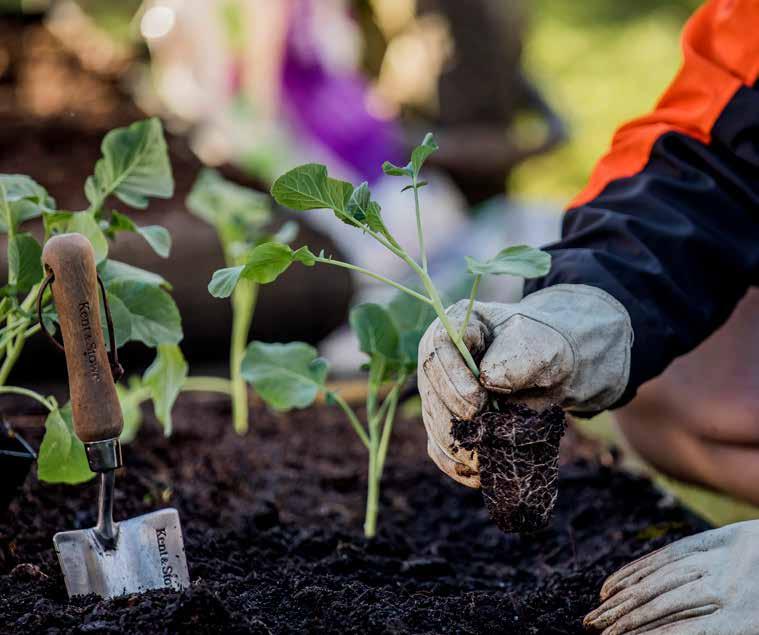





Getyourgarden really growing visit mitre10.co.nz/gardening-tips Exclusive to Farmlands Card holders only. Prices and discounts shown are current as at 18/01/2023 and are subject to change. Please see mitre10.co.nz for the most up to date retail price and to find your nearest store. Not in conjunction with any other offer or discount. Farmlands discount available in-store only, not available online. RETAIL PRICE $19.98 Farmlands Price $17 98 Tesselaar Rose Flower Carpet® Mini Cherry 2.5L 384715 RETAIL PRICE $36.97 Farmlands Price $ 3142 Living Interiors Ficus Black Night 1.5L 351400 RETAIL PRICE $15.98 Farmlands Price $1358 Tui Certified Organic Compost 30L 238104 RETAIL PRICE $39.98 Farmlands Price $ 3398 Kiwicare NO Bugs Super Insect Control Spray 2L 174183 RETAIL PRICE $32.98 Farmlands Price $ 2498 Roundup Naturals Ready to Use Weedkiller 1L 352168
HOUSE FIRE PREVENTION – ADVICE FROM FMG


When it’s time to put the clocks back at the end of daylight savings on Sunday 2 April, it’s also time to check your smoke alarms as well as other potential fire hazards around the home ahead of winter.
Autumn is also a good time to clear your driveway of low branches and other obstructions so that emergency services can access your property should a fire occur.
Rural properties are more likely to use wood fires and the damage caused can be worse due to the extra time it takes for emergency services to arrive, so prevention is key.
Check your smoke alarms
Fire and Emergency New Zealand states that one third (33%) of the residential fires attended last year did not have smoke alarms installed. Smoke alarms do save lives.
Dispose of ashes safely
Even after a fire is out, the ashes can stay warm for up to five days and can reignite. Place the ashes in a steel
bucket and soak them in water until cool. It’s important to ensure the bucket is stored in an open and safe place away from the house, decking or garden area.
Sweep your chimney
It’s also important to inspect your fireplaces and chimneys for deterioration and get your flue swept annually. Chimney fires can spread into ceilings and walls causing extensive damage to your house.
If you’re concerned, ask a certified expert to inspect your fireplace and chimney for deterioration.
Use a fireguard
Make sure you have a fireguard to prevent sparks and embers from starting a fire on nearby rugs and carpets.
1 IN 6 HOUSE FIRE CLAIMS ARE CAUSED BY FIRES OR FIREPLACES
To learn more about the causes of house fires and advice on how to reduce fire risks, check out FMG’s House Fires Advice Guide at www.fmg.co.nz/advice/ house-fires or head to Fire and Emergency New Zealand's website www.fireandemergency.nz
86 | Farmlander | farmlands.co.nz In association with FMG
Weatherboards in Resene Double Stack anchor this home in its rural landscape, while heritage features and trim in Resene Double Alabaster keep the exterior fresh and sharp.
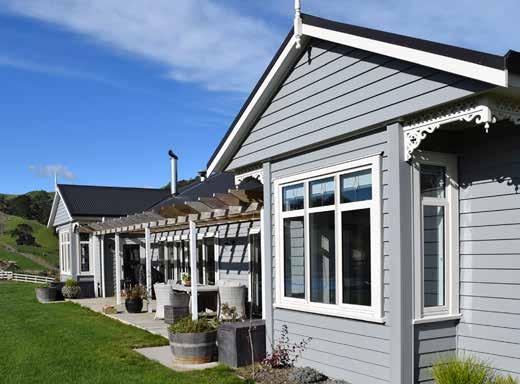
Resene Double Alabaster
Resene Double Stack
Does your home’s colour scheme fit your landscape?
If you have said ‘goodbye’ to the city life and your home is rural, rustic and relaxed it may be that the sophisticated and contemporary colour schemes of the houses in the urban streets aren't right for you.
You may have gumboots at the back door, lots of cows to milk and chickens in the pen or a newly built country home with acres of pasture and lush gardens and a lifestyle of peace and plenty. Either way you may have decided that the exterior of your home may need to reflect the natural environment. And with the warm weather, it’s the perfect time to plan your exterior paint jobs.
Here are some ideas to get you started to enhance your home and fit in with your surrounding landscape…
• If you have views of rolling hills and a soft merging of house and bush – Try Resene Half Linen, Resene Quarter Rice Cake and Resene Karaka, or Resene Half Fossil, Resene Double Alabaster and Resene Canyon.
• If you have views of grapevines marching to the horizon, orchards and traditional hedgerows – Try Resene Villa White, Resene Quarter Villa White and Resene Scoria, or Resene Double Ash, Resene Helium and Resene Twizel.
Resene Quarter Villa White
Resene Villa White
Resene Helium Resene Twizel
Resene Scoria Resene Double Ash
• If you have views of coastal vistas and windswept dunes under acres of sky – Try Resene Sea Fog, Resene Half Alabaster and Resene Lighthouse, or Resene Duck Egg Blue, Resene Quarter Black White or Resene Explorer.
Resene Sea Fog Resene Half Alabaster
Resene Double Alabaster
Resene Half Fossil
Resene Half Linen
Resene Canyon
Resene Quarter Rice Cake Resene Karaka
• If you have views of rock strewn mountain peaks etched against the bright blue skies above bleached crop fields –Try Resene Quarter Craigieburn, Resene Half Merino and Resene New Denim Blue, or Resene Eighth Arrowtown, Resene Double Black White and Resene Groundbreaker.
Resene Duck Egg Blue Resene Quarter Black White Resene Explorer
Resene Lighthouse
If you need help choosing the best products and colours for your decorating project, use the free online Resene Ask a Colour Expert (www.resene.co.nz/colourexpert) or Resene Ask a Paint Expert (www.resene.co.nz/paintexpert) services. Resene experts will provide tailor-made advice for your project direct to your inbox. Or contact or visit your nearest Resene ColorShop for free helpful and friendly advice.
Resene Quarter Craigieburn
Resene Half Merino Resene New Denim Blue
Resene Double Black White Resene Groundbreaker


Colours
Resene Eighth Arrowtown
www.resene.com 0800 737 363
farmlands.co.nz | Farmlander | 87 In association with Resene
as close as printing allows. Always view a physical sample or try a Resene testpot before making your final choice.
A FAMILY AFFAIR
Kenneth and Catherine McKenzie arrived in Port Chalmers aboard the Lady Egidia in 1860 from Scotland.
Kenneth (K.G.) panned for gold at Gabriel’s Gully, then worked as a shepherd until 1869 when he acquired his first property of 50 acres and called it ‘Greenbush’.
K.G. and Catherine had seven children. Greenbush ran cows in the 1880s, supplying the Fortrose and Otara dairy factories. Over the years more land was purchased to the extent that by the time of K.G’s death in 1901, he had settled his three surviving sons on separate farms.

K.G.’s eldest surviving son, Kenneth, took over Greenbush and he and his wife, Annie had eight children. Kenneth set up a Border Leicester stud in 1911 and was also well known for the quality of his bullocks and the size of his swedes. Kenneth built the existing farmhouse in 1923 which is still lived in by the fifth generation.
Following Kenneth’s death in 1929, eldest son Donald took over Greenbush. He and his wife Ann had five children. Donald traded stock all over Southland and employed drovers with a good eye for stock. He ran Romney sheep and beef cattle on the farm until his death in 1964.
Donald’s sons, Donald and Colin purchased Ocean View together in 1965 and that partnership took on Greenbush until it was dissolved in 1981. Donald and Ann took over Greenbush and his brother stayed with Ocean View.
McKenzie FORTROSE, SOUTHLAND 1869 SESQUICENTENNIALFARM 2019NEW ZEALAND
Donald and Ann had four boys and ran Coopworth sheep and Simmental cattle. They winter grazed dairy cows and ran a successful B&B at the homestead.
Donald and Ann’s son, Scott and his wife, Christine began leasing Greenbush in 2000 and ran Coopdale sheep, beef cattle and winter grazed dairy cows. They purchased the farm in 2004. Prior to that, they had purchased 80ha of a neighbouring block and this was run as a dairy grazing block while Scott helped his father on the farm and ran a fencing contracting business while also driving trucks. Donald and Ann continued to live in the homestead and run their B&B.
After much thought and discussion, a decision was made to convert to dairy in 2007, running about 650 cows. Nine hundred and fifty cows are presently run.
In 2012, Donald and Ann moved into their new home built on the Fortrose Hill and Scott and Christine moved into
the homestead with their three children. Over the years other blocks of land were purchased, now making Greenbush a total of 761ha, employing four permanent staff and one relief milker.
Scott and Christine are involved in the running of the farm and work alongside the Herd Manager of the dairy farm.
Scott and Christine’s eldest son Oliver, having completed his first year at Lincoln University, is working in Balfour. One of his goals is to operate grain harvesters overseas before settling back into Southland on the family farm. Oliver has the passion for farming and if he chooses to continue in his father’s footsteps, he will be the sixth generation McKenzie farming on Greenbush. Their daughter, Georgia is attending Lincoln University studying land and property management and their youngest son, Elliot is in Year 12 at Southland Boys.
88 | Farmlander | farmlands.co.nz
The New Zealand Century Farm and Station Awards aim to capture and preserve the history of our country’s farming families. We share stories from Farmlands shareholders who have worked their land for 100 years or more.
Five generations of McKenzies.
HAVE YOUR SAY
Wherever you are in the country, whatever you have to say,
we want to hear it.
Your feedback has helped Farmlands become more efficient, more competitive and more in touch with what’s going on in your life.


Which means greater profitability for your business and a better outcome all round.

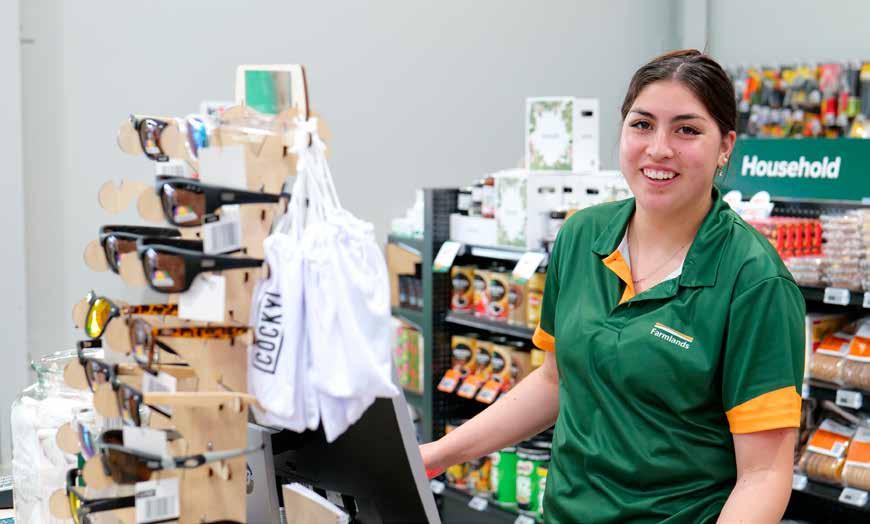
VOICE COUNTS
our feedback panel or complete our customer survey today by scanning the QR code.
YOUR
Join
LOCAL TAKES THE LEAD ON HEMP
“If we look into the future, and really come to understand what the potential could look like, that’s where I think we’ll start to see its impact really come to the fore,” says Brad Lake, Co-Founder of The Brother’s Green, one of the few hemp companies in New Zealand.
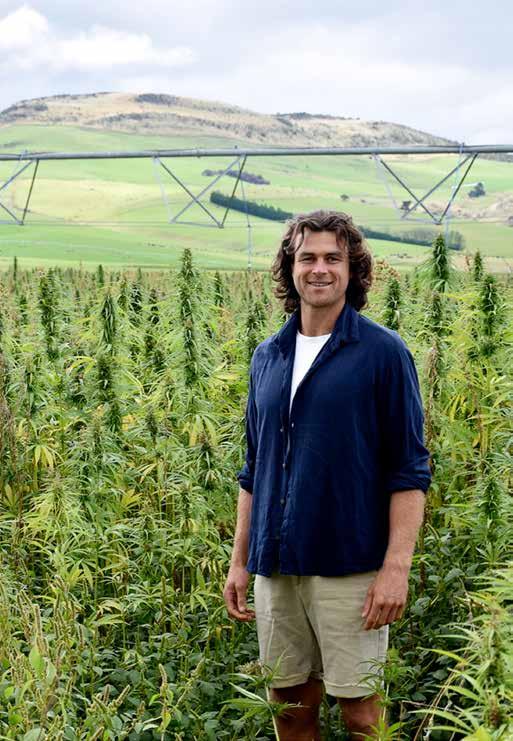
Initially coming from rural banking, Brad teamed up with pharmacist Brendon McIntosh after discovering the miracle plant that is hemp. “If you look at hemp as just a crop, I found that it fits a lot of those needs against economic and environmental challenges, as well as on a health level.” And so it does. A sustainable crop that drives a significant amount of carbon into the soil, takes a lot less water and inputs than many other crops, coupled with the health benefits – it’s a no-brainer.
One of hemp’s main benefits is reducing inflammation, making it a hero product for diseases like arthritis and psoriasis. Initially, Brad and the team had known the general benefits, high in protein, nutrients, omega 3, but hadn’t thought about hemp targeting anything specific. “We started to get feedback that people were experiencing benefits particularly for arthritis and joint health. We weren’t even telling them that was what it was good for, but we were getting all these testimonials and it happened to work out the best possible way,” says Brad. Testimonials evident upon visiting The Brother's Green website, five-star reviews detailing customer’s decreased pain, clear skin, the positive results are endless. But it was only about 18 months ago that the team realised they would feel comfortable marketing to those specific conditions.
WORDS BY HANNAH TWOMEY AARON FRANKS
Although early focus geared towards the environmental, natural benefits of hemp, Brad says the progression has come quite organically after seeing customer’s results. “What we’ve uncovered is that it isn’t that which sells hemp to our customers, the focus is now that we’re selling an arthritis product, or a gut health product, and it just happens to be that
90 | Farmlander | farmlands.co.nz
Changing public perception on hemp one step at a time, The Brother’s Green have switched up their journey after customer feedback, marketing this misunderstood plant to a global market.
hemp is the main ingredient,” says Brad. “The market has gone from people who know about hemp and love hemp to people who have health problems, and those markets are a lot bigger.”
This has helped overcome the barrier that hangs around the perception of hemp – marijuana’s distant cousin. Most would hear hemp, think weed. However, hemp has only extremely low levels of THC and has no psychoactive effects, making it an effective natural remedy for chronic health conditions.
Spreading the word through grassroots education strategies led by Brad in the early days of The Brother’s Green was crucial in their journey. “As soon as people, particularly the older generations, come to understand that there’s nothing psychoactive in hemp, their mind just completely changes and opens up to the possibilities. All of those other benefits actually become real.” Seeing the shift in perceptions of people wanting more natural remedies as opposed to pharmaceutical medicine has been rewarding for The Brother’s Green, especially coupled with the results that don’t come with side effects

of traditional medication. “There’s more local solutions to these problems, and that’s really cool,” says Brad.
The hemp is grown and processed in Culverden, where the seed is turned into one of three ingredients – oil, protein powder, or the whole seed. Current NZ legislation only allows for the seed to be consumed, which means the rest of the plant gets sold as garden mulch. From the three raw ingredients there are many different avenues to go down, which Brad says has been a challenge to hone in on one range. “It’s been a big learning curve, trying not to do everything and actually just focusing on one key product range and key target markets, rather than spreading yourself too thin.”

The Brothers Green’s current product range includes skincare and food supplements, but they are looking to expand within the next few months into capsules and more. Brad is hoping for more
export opportunities to give their products increased exposure to the international market, building on the customer base around Australia, Japan and South Korea.
The Brother’s Green current focus is on the retail range, adding value to the product, looking into how they can improve through aspects like branding or additional ingredients, which Brad says has been exciting so far. They will also continue to hone in on their messaging, despite facing advertising blocks on social media – with hemp, you’ve always got to think outside the box. “One of the challenging things with hemp, is you’re sort of writing your own script, as there’s not too much information out there at the moment. But I think those networks will start to grow with farmers' reps and tours, the more people start to feel it’s normalised and hopefully we start to see more knowledge and interest.”
LAY OF THE LAND | Local leader farmlands.co.nz | Farmlander | 91
“We started to get feedback that people were experiencing benefits particularly for arthritis and joint health.” – BRAD LAKE
Opposite: Brad in The Brother's Green hemp field in Culverden.
Right: Drylands hemp crop in February just before harvest which only had 11mm of rain since planting in November.
Hi Andy. You’re new to the business. Yes, I have been with the co-operative since mid-October, so still very new to all things Farmlands.
Where have you been?
My background is in Consumer Finance, working in the interest free space for just over 10 years. Prior to that I spent 12 years in a variety of roles at Noel Leeming, predominantly as a branch manager.
In previous roles I’ve focused on relationship management and key account management of national partners. My focus then changed to business development, moving to a National Head of Growth position.
What do you do at Farmlands?
I have come to Farmlands as a Business Development Manager but will also be supporting my colleagues with some national partner relationship management duties.
What value does your role bring to shareholders?
A key message within Farmlands is supporting farmer profitability. As a BDM I need to keep that in mind as I work with new partners and expand the Card offering to shareholders.
As far as value goes to our members, my role means a few things. I work with existing Card Partners to ensure their offer is the best it can be. We need to be balanced in ensuring we’re providing the best offering to the shareholder but also remaining in a position where our Partners want to continue to work with us. We want our Partners keen to see Farmlands Cards being presented and knowing the Farmlands relationship delivers real value to their business.
I also develop new Card Partnerships to further extend the offering to the shareholder. A key focus for me is to ensure the farmer, grower and lifestyler is catered for in all areas of their life and I want to find Partners that support life in and out of business. This means I need to look at spending trends and ensure we partner with businesses in sectors that help us to round out the Card offering to the shareholder.
What has particularly impressed you about partner relationships at Farmlands?

Coming into Farmlands, there is a real focus on our history, which I think is great as there is a lot to be proud of. The what, the who and the why of Farmlands was really evident during the recruitment and onboarding processes.
The Partner relationships I have witnessed within our Card Partnership team is quite unique. The entire Card Partnership team works very hard to maintain that win, win, win ethos for the shareholder, Partner, and the co-operative. The deep level of engagement I’ve seen from my colleagues is impressive and now I get to be part of that.
Partnership meetings are about understanding product and range developments, ways to communicate offers to the shareholder, or process improvements to provide an overall improved customer experience. The Partners we are working with really value Farmlands, and more importantly the shareholder. All of which is aligned to the focus of a more profitable farming journey.
What is your approach to new business?
It’s inquisitive, especially in respect to the value a new Partner may bring to shareholders. I then need to consider this with how any new partnership would align to what we offer already in a Farmlands store, or from an existing Partner.
From what I have seen, I feel that a great amount of work has been done to bring on a wide range of valuable Partners, that provide a vast offering to the shareholder.
My plan moving forward is to look with a different lens into products or services that may not have been considered, or overlooked, or not deemed appropriate previously.
I want to ensure the Farmlands Card can be used in as many instances as possible to deliver value and make life easier for the shareholder.
92 | Farmlander | farmlands.co.nz
Andy Clark.
Get in touch with Andy at Andy.Clark@Farmlands.co.nz
We sit down with one of Farmlands’ newest recruits, Card Partner Development Manager Andy Clark, for a chat about finding his feet in a new organisation and adding value to the area of partner relationships.






farmlands.co.nz | Farmlander | 93 *T&Cs apply. Discounts and prices are subject to change. If the promotional price is better than the shareholder price, you will receive no further discount. Terms and conditions apply. Payment must be made using Farmlands Card only. Any freight or installation costs required will be charged at the normal rate. Colours and stock may vary. Offers available to Farmlands shareholders and secondary account holders only. While stock lasts. You’ll probably ask if we charged you correctly. With exclusive prices on beds, furniture and appliances –thanks to your Farmlands Card. Head instore to your local, or shop online – no stress. You can now use your Farmlands Card online at smithscity.co.nz
Living rurally and running a farm can be expensive, especially with the costof-living increasing steadily. With around 4,000 Card Partners and more than 7,000+ Card Partner locations nationwide, it’s all about working smarter, not harder.
The first step to find your way to savings is discovering which retailers are Card Partners in your area. To help with this, Farmlands have an easy-to-use online Card Partner directory. Card holders can simply use the filters to search for retail categories in their area. It also includes a filter that will bring up which online retailers will accept the Card as well.
These Card Partners are carefully selected by the team at Farmlands to ensure they are relevant brands and retailers to account holders and have a considerable reach across the country.
“When we are considering a partner, particularly a national partner, it needs to be truly national. We look at all the different parts, not just about the discount they are prepared to offer because we want to make sure that for any of our partners, our shareholders can have confidence in the products and services that they provide,” says Iain O'Rourke, Farmlands Commercial Manager.
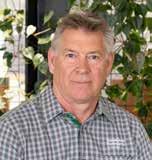
The Farmlands Card is also unique in that every account holder can see their savings on their monthly statement. And the best part? This is consolidated into one IRD approved bill each month making it easy to keep track of your expenses and savings.
“That means that you don’t have to hold onto a whole lot of receipts when you do your shopping. We capture that business spend. When you look at your Farmlands statement, if it is business spend then we will try and provide as much detail on that tax invoice statement at the end of the month.”
It can also be uploaded to your accounting software to make managing the books easy “or you can give your software provider permission to access your data and upload on your behalf,” adds Iain.
With exclusive shareholder discounts and rebates through Farmlands Card Partners, there are so many savings at your fingertips when you reach for your Farmlands Card.
A FEW OF OUR CARD PARTNERS
Z Energy
• Save 12c per litre off the pump price at Z, Caltex and Challenge
Meridian
• An industry-leading five year Fixed Rate Plan, which includes your network charges 1
• Competitive pricing with seasonal plans that align to your calendar (Apr – Oct)
• A 2% Meridian Energy partnership discount 2
• A 2% shareholder rebate 3 for paying through Farmlands
Torpedo7
• Shareholders save on average, 30% per transaction.
Repco
• 5% rebate on all purchases in-store or online
Property Brokers
• Farmlands shareholders (residential, lifestyle, rural) who list exclusively with Property Brokers receive the following commission rate and benefits. 4
– 3.75% to first $500,000
– 2% on the balance plus GST
– No administration fee
Ford
• Exclusive pricing on the full range of new Ford vehicles.
Elgas
• 10% shareholder rebate off every Elgas bill. 5
MITRE 10
• Save up to 15% on all products storewide 6
Honda
• 2.5% discount on Honda parts and accessories
Bridgestone
• 30% off selected Bridgestone and Firestone car, 4x4 and van tyres 7
• 25% off selected Supercat and Dayton car, 4x4 and van tyres 7
• 30% off selected Bridgestone and Firestone agricultural tyres 8 and remember our other strategic partners
ASB, FMG and Spark.
1.Terms and conditions and eligibility criteria apply.
2. Discount applies for Non-Half Hourly sites only.
3. Excludes TOU sites. Terms and conditions apply.
4. Commercial and Forestry transactions are excluded from this offer.
5. Reticulated gas is not eligible for this offer and not able to be billed through Farmlands Accounts.
6. Excludes all gift vouchers and prepaid cards.
7. Savings on car, 4x4 and van tyres are off recommended retail tyre price, excluding fitting and balancing charges. Normal fitting and balancing charges apply. All tyres must be fitted in-store at the time of purchase.
8. Savings on agricultural tyres are off List Price, excluding fitting.
94 | Farmlander | farmlands.co.nz
From discounted farm inputs, power, fuel and savings for the home, here's how to make the most of your shareholding.
IAIN O'ROURKE FARMLANDS COMMERCIAL MANAGER
GET IN THE KNOW ON WHERE TO GO

Your Farmlands Card gives you access to the best deals at over 7,000 Card Partner locations nationwide.


Our Card Partner Directory makes it easier than ever to find those deals near you.



Scan the QR code or go to cardpartners.farmlands.co.nz to find Card Partners near you.






THE LAST WORD
PROPERTY PRIORITIES
From succession planning to land diversification Wynn Williams has a long history of supporting clients in the rural sector. Here partner and specialist property lawyer Annabel Sheppard shares her expert advice on rural property management.

Like with any major purchase, if you’re thinking about buying a farm or agricultural land it’s important to allow enough time to complete due diligence. Approach things on a ‘no surprises’ basis. Know exactly the state of the land, what the relevant resource consents are and any requirement to have them transferred and have a full understanding of any water supply agreements well in advance of the final sale and purchase negotiations. This due diligence takes time and too often we find our clients in a position where they need to act quickly.
It’s also especially important that clients liaise with their bank early on to get a clear understanding of what they can lend. Banks often need up-to-date financials in order to process loan applications and then there’s the question of whether this is realistically serviceable.
If you are thinking of selling your farm, make sure you take time to liaise not only with your lawyer but also with your accountant. Financial records need to be current and it’s important to take time to determine the right apportionments of the purchase price as this may have tax consequences.
How important is succession planning when it comes to farming property? Succession planning in relation to farm properties takes time. Time and teamwork are key.
In terms of professional support, it’s best your accountant and lawyer
work together and succession planning works best when there is communication with all family members who are impacted. Often, this is a highly emotive exercise and tensions can run high, so enabling input from all relevant parties ensures everyone has access to the appropriate information, concerns are addressed and any unexpected surprises or unnecessary confrontation dissipated.
And having a will in place?
Having an up-to-date will in place is critical and you need to make sure it aligns with the overall succession plan. Often farms are owned by companies and/or trusts, or alternatively, the trust may be a shareholder of the land-owning company. Therefore, in any succession planning it’s not just a matter of looking at your will but looking at your company structure and/or trust structure to ensure they’re aligned so your succession plan can in fact be implemented. It is also important that these documents are reviewed regularly to keep them fit for purpose.
For farmers looking to diversify their operations, what due diligence should be done?
If there is going to be any change in use of the underlying farm operation it is absolutely critical appropriate due diligence is undertaken. This will involve liaising with farm consultants and other people in the wider sector, including the local council or territorial authority to check that the land is appropriate for the diversification and has the necessary consents and water rights or water supply agreements in place. And then there is the health and safety and regulatory compliance that comes with certain land-based activity. Be aware that diversification is a costly exercise.
What advice do you have for farmers navigating the challenges of the next 12 months?
Fluctuating interest rates and regulatory change can have a significant impact on your business. To avoid having to make some tough decisions or defer capital expenditure it’s important to keep abreast of cash flow for the farming operation and regularly review your budgeting and any future development plans.
If you find yourself in a position where you’re struggling with your financial obligations, it is crucial to keep in regular contact with your banker. Often steps can be put in place to help create more flexibility with loan repayments and other options.
Seek advice – it’s there to help you, not penalise you.
96 | Farmlander | farmlands.co.nz
Annabel Sheppard.
FARMING IS EVERY DAY, SO OUR FUEL DISCOUNTS ARE TOO.

GET 12c OFF PER LITRE* EVERY TIME YOU SWIPE YOUR FARMLANDS CARD AT Z, CALTEX OR CHALLENGE.

*Rebate of 12c per litre off the pump price at Z, Caltex or Challenge when using your Farmlands Card. Not to be used in conjunction with any other offer. FAR_10750



Grab your share of more than 35,000 native trees. Talk to your Farmlands TFO or Ballance Nutrient Specialist today. *Terms and conditions apply. Purchase selected Ballance fertiliser through your Farmlands Account and receive a free New Zealand native tree for every tonne of fertiliser purchased after the first 30 Tonnes. Maximum of 120 trees per shareholder. Promotional period 1st February – 31st May 2023. Please visit www.farmlands.co.nz/terms for more information. Buy Ballance Fertiliser through Farmlands this autumn and get one native tree for every tonne after the first 30 tonnes.* FAR_10805 N ORFOL K RO AD NURSERY




























 WORDS BY AYLA MILLER CHLOE LODGE
WORDS BY AYLA MILLER CHLOE LODGE





















































 WORDS BY ALICE SCOTT
WORDS BY ALICE SCOTT












 WORDS BY ALICE SCOTT
DR ROB DERRICK HEAD OF PRODUCT DEVELOPMENT
WORDS BY ALICE SCOTT
DR ROB DERRICK HEAD OF PRODUCT DEVELOPMENT


 WORDS BY KAREN FRASER & STACEY COSNETT
WORDS BY KAREN FRASER & STACEY COSNETT





























































































